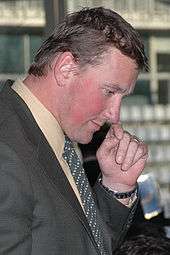University of Oxford
The University of Oxford (legally The Chancellor, Masters and Scholars of the University of Oxford) is a collegiate research university in Oxford, England. There is evidence of teaching as early as 1096,[2] making it the oldest university in the English-speaking world and the world's second-oldest university in continuous operation.[2][10] It grew rapidly from 1167 when Henry II banned English students from attending the University of Paris.[2] After disputes between students and Oxford townsfolk in 1209, some academics fled north-east to Cambridge where they established what became the University of Cambridge.[11] The two English "ancient universities" share many common features and are often jointly called "Oxbridge".
 | |
| Latin: Universitas Oxoniensis | |
Other name | The Chancellor, Masters and Scholars of the University of Oxford[1] |
|---|---|
| Motto | Latin: Dominus illuminatio mea |
Motto in English | The Lord is my light |
| Type | Public research university |
| Established | c. 1096[2] |
| Endowment | £6.1 billion (including colleges) (as of 31 July 2019)[3] |
| Budget | £2.45 billion (excluding colleges) (2018–19)[3] |
| Chancellor | The Lord Patten of Barnes |
| Vice-Chancellor | Louise Richardson[4][5] |
Academic staff | 7000+ [6] |
| Students | 24,515 (2019) [7] |
| Undergraduates | 11,955 |
| Postgraduates | 12,010 |
Other students | 541 (2017)[8] |
| Location | , England, United Kingdom 51°45′18″N 01°15′18″W |
| Campus | University town |
| Colours | Oxford Blue[9] |
| Athletics | The Sporting Blue |
| Affiliations | IARU Russell Group Europaeum EUA Golden Triangle G5 LERU SES Universities UK |
| Website | ox |
 | |
The university is made up of 39 semi-autonomous constituent colleges, six permanent private halls, and a range of academic departments which are organised into four divisions.[12] All the colleges are self-governing institutions within the university, each controlling its own membership and with its own internal structure and activities. All students are members of a college.[13] It does not have a main campus, and its buildings and facilities are scattered throughout the city centre. Undergraduate teaching at Oxford is organised around weekly small-group tutorials at the colleges and halls – a feature unique to the Oxbridge system. These are supported by classes, lectures, seminars, laboratory work and occasionally further tutorials provided by the central university faculties and departments. Postgraduate teaching is provided predominantly centrally.
Oxford operates the world's oldest university museum, as well as the largest university press in the world[14] and the largest academic library system nationwide.[15] In the fiscal year ending 31 July 2019, the university had a total income of £2.45 billion, of which £624.8 million was from research grants and contracts.[3]
Oxford has educated a wide range of notable alumni, including 28 prime ministers of the United Kingdom and many heads of state and government around the world.[16] As of November 2019, 72 Nobel Prize laureates, 3 Fields Medalists, and 6 Turing Award winners have studied, worked, or held visiting fellowships at the University of Oxford, while its alumni have won 160 Olympic medals.[17] Oxford is the home of numerous scholarships, including the Rhodes Scholarship, one of the oldest international graduate scholarship programmes.[18]
History
Founding
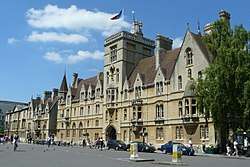
The University of Oxford has no known foundation date.[19] Teaching at Oxford existed in some form as early as 1096, but it is unclear when a university came into being.[2] It grew quickly from 1167 when English students returned from the University of Paris.[2] The historian Gerald of Wales lectured to such scholars in 1188 and the first known foreign scholar, Emo of Friesland, arrived in 1190. The head of the university had the title of chancellor from at least 1201, and the masters were recognised as a universitas or corporation in 1231. The university was granted a royal charter in 1248 during the reign of King Henry III.[20]
After disputes between students and Oxford townsfolk in 1209, some academics fled from the violence to Cambridge, later forming the University of Cambridge.[11][21]

The students associated together on the basis of geographical origins, into two 'nations', representing the North (northerners or Boreales, who included the English people from north of the River Trent and the Scots) and the South (southerners or Australes, who included English people from south of the Trent, the Irish and the Welsh).[22][23] In later centuries, geographical origins continued to influence many students' affiliations when membership of a college or hall became customary in Oxford. In addition, members of many religious orders, including Dominicans, Franciscans, Carmelites and Augustinians, settled in Oxford in the mid-13th century, gained influence and maintained houses or halls for students.[24] At about the same time, private benefactors established colleges as self-contained scholarly communities. Among the earliest such founders were William of Durham, who in 1249 endowed University College,[24] and John Balliol, father of a future King of Scots; Balliol College bears his name.[22] Another founder, Walter de Merton, a Lord Chancellor of England and afterwards Bishop of Rochester, devised a series of regulations for college life;[25][26] Merton College thereby became the model for such establishments at Oxford,[27] as well as at the University of Cambridge. Thereafter, an increasing number of students lived in colleges rather than in halls and religious houses.[24]
In 1333–1334, an attempt by some dissatisfied Oxford scholars to found a new university at Stamford, Lincolnshire, was blocked by the universities of Oxford and Cambridge petitioning King Edward III.[28] Thereafter, until the 1820s, no new universities were allowed to be founded in England, even in London; thus, Oxford and Cambridge had a duopoly, which was unusual in large western European countries.[29][30]
Renaissance period
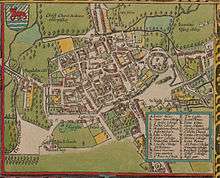
The new learning of the Renaissance greatly influenced Oxford from the late 15th century onwards. Among university scholars of the period were William Grocyn, who contributed to the revival of Greek language studies, and John Colet, the noted biblical scholar.
With the English Reformation and the breaking of communion with the Roman Catholic Church, recusant scholars from Oxford fled to continental Europe, settling especially at the University of Douai.[31] The method of teaching at Oxford was transformed from the medieval scholastic method to Renaissance education, although institutions associated with the university suffered losses of land and revenues. As a centre of learning and scholarship, Oxford's reputation declined in the Age of Enlightenment; enrolments fell and teaching was neglected.
In 1636[32] William Laud, the chancellor and Archbishop of Canterbury, codified the university's statutes. These, to a large extent, remained its governing regulations until the mid-19th century. Laud was also responsible for the granting of a charter securing privileges for the University Press, and he made significant contributions to the Bodleian Library, the main library of the university. From the beginnings of the Church of England as the established church until 1866, membership of the church was a requirement to receive the BA degree from the university and "dissenters" were only permitted to receive the MA in 1871.[33]
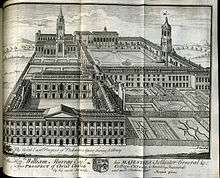
The university was a centre of the Royalist party during the English Civil War (1642–1649), while the town favoured the opposing Parliamentarian cause.[34] From the mid-18th century onwards, however, the university took little part in political conflicts.
Wadham College, founded in 1610, was the undergraduate college of Sir Christopher Wren. Wren was part of a brilliant group of experimental scientists at Oxford in the 1650s, the Oxford Philosophical Club, which included Robert Boyle and Robert Hooke. This group held regular meetings at Wadham under the guidance of the college's Warden, John Wilkins, and the group formed the nucleus that went on to found the Royal Society.
Modern period
Students
Before reforms in the early 19th century the curriculum at Oxford was notoriously narrow and impractical. Sir Spencer Walpole, a historian of contemporary Britain and a senior government official, had not attended any university. He says, "few medical men, few solicitors, few persons intended for commerce or trade, ever dreamed of passing through a university career." He quotes the Oxford University Commissioners in 1852 stating: "The education imparted at Oxford was not such as to conduce to the advancement in life of many persons, except those intended for the ministry."[35] Nevertheless, Walpole argued:
Among the many deficiencies attending a university education there was, however, one good thing about it, and that was the education which the undergraduates gave themselves. It was impossible to collect some thousand or twelve hundred of the best young men in England, to give them the opportunity of making acquaintance with one another, and full liberty to live their lives in their own way, without evolving in the best among them, some admirable qualities of loyalty, independence, and self-control. If the average undergraduate carried from University little or no learning, which was of any service to him, he carried from it a knowledge of men and respect for his fellows and himself, a reverence for the past, a code of honour for the present, which could not but be serviceable. He had enjoyed opportunities... of intercourse with men, some of whom were certain to rise to the highest places in the Senate, in the Church, or at the Bar. He might have mixed with them in his sports, in his studies, and perhaps in his debating society; and any associations which he had this formed had been useful to him at the time, and might be a source of satisfaction to him in after life.[36]
Out of the students who matriculated in 1840, 65% were sons of professionals (34% were Anglican ministers). After graduation 87% became professionals (59% as Anglican clergy). Out of the students who matriculated in 1870, 59% were sons of professionals (25% were Anglican ministers). After graduation 87% became professionals (42% as Anglican clergy).[37][38]
M. C. Curthoys and H. S. Jones argue that the rise of organised sport was one of the most remarkable and distinctive features of the history of the universities of Oxford and Cambridge in the late 19th and early 20th centuries. It was carried over from the athleticism prevalent at the public schools such as Eton, Winchester, Shrewsbury, and Harrow.[39]
All students, regardless of their chosen area of study, were required to spend (at least) their first year preparing for a first year examination that was heavily focused on classical languages. Science students found this particularly burdensome and supported a separate science degree with Greek language study removed from their required courses. This concept of a bachelor of science had been adopted at other European universities (London University had implemented it in 1860) but an 1880 proposal at Oxford to replace the classical requirement with a modern language (like German or French) was unsuccessful. After considerable internal wrangling over the structure of the arts curriculum, in 1886 the "natural science preliminary" was recognized as a qualifying part of the first year examination.[40]
At the start of 1914 the university housed about 3,000 undergraduates and about 100 postgraduate students. During the First World War many undergraduates and fellows joined the armed forces. By 1918 virtually all fellows were in uniform, and the student population in residence was reduced to 12 per cent of the pre-war total.[41] The University Roll of Service records that, in total, 14,792 members of the university served in the war, with 2,716 (18.36%) killed.[42] Not all the members of the university who served in the Great War were on the Allied side; there is a remarkable memorial to members of New College who served in the German armed forces, bearing the inscription, 'In memory of the men of this college who coming from a foreign land entered into the inheritance of this place and returning fought and died for their country in the war 1914–1918'. During the war years the university buildings became hospitals, cadet schools and military training camps.[41]
Reforms
Two parliamentary commissions in 1852 issued recommendations for Oxford and Cambridge. Archibald Campbell Tait, former headmaster of Rugby School, was a key member of the Oxford Commission; he wanted Oxford to follow the German and Scottish model in which the professorship was paramount. The commission's report envisioned a centralised university run predominantly by professors and faculties, with a much stronger emphasis on research. The professional staff should be strengthened and better paid. For students, restrictions on entry should be dropped, and more opportunity given to poorer families. It called for an enlargement of the curriculum, with honours to be awarded in many new fields. Undergraduate scholarships should be open to all Britons. Graduate fellowships should be opened up to all members of the university. It recommended that fellows be released from an obligation for ordination. Students were to be allowed to save money by boarding in the city, instead of in a college.[43][44]
The system of separate honour schools for different subjects began in 1802, with Mathematics and Literae Humaniores.[45] Schools of "Natural Sciences" and "Law, and Modern History" were added in 1853.[45] By 1872, the last of these had split into "Jurisprudence" and "Modern History". Theology became the sixth honour school.[46] In addition to these B.A. Honours degrees, the postgraduate Bachelor of Civil Law (B.C.L.) was, and still is, offered.[47]

The mid-19th century saw the impact of the Oxford Movement (1833–1845), led among others by the future Cardinal John Henry Newman. The influence of the reformed model of German universities reached Oxford via key scholars such as Edward Bouverie Pusey, Benjamin Jowett and Max Müller.
Administrative reforms during the 19th century included the replacement of oral examinations with written entrance tests, greater tolerance for religious dissent, and the establishment of four women's colleges. Privy Council decisions in the 20th century (e.g. the abolition of compulsory daily worship, dissociation of the Regius Professorship of Hebrew from clerical status, diversion of colleges' theological bequests to other purposes) loosened the link with traditional belief and practice. Furthermore, although the university's emphasis had historically been on classical knowledge, its curriculum expanded during the 19th century to include scientific and medical studies. Knowledge of Ancient Greek was required for admission until 1920, and Latin until 1960.
The University of Oxford began to award doctorates for research in the first third of the 20th century. The first Oxford DPhil in mathematics was awarded in 1921.[48]
The mid-20th century saw many distinguished continental scholars, displaced by Nazism and communism, relocating to Oxford.
The list of distinguished scholars at the University of Oxford is long and includes many who have made major contributions to politics, the sciences, medicine, and literature. As of October 2019, more than 70 Nobel laureates and more than 50 world leaders have been affiliated with the University of Oxford.[16]
Women's education
The university passed a statute in 1875 allowing examinations for women at roughly undergraduate level;[49] for a brief period in the early 1900s, this allowed the "steamboat ladies" to receive ad eundem degrees from the University of Dublin.[50] In June 1878, the Association for the Education of Women (AEW) was formed, aiming for the eventual creation of a college for women in Oxford. Some of the more prominent members of the association were George Granville Bradley, T. H. Green and Edward Stuart Talbot. Talbot insisted on a specifically Anglican institution, which was unacceptable to most of the other members. The two parties eventually split, and Talbot's group founded Lady Margaret Hall in 1878, while T. H. Green founded the non-denominational Somerville College in 1879.[51] Lady Margaret Hall and Somerville opened their doors to their first 21 students (12 from Somerville, 9 from Lady Margaret Hall) in 1879, who attended lectures in rooms above an Oxford baker's shop.[49] There were also 25 women students living at home or with friends in 1879, a group which evolved into the Society of Oxford Home-Students and in 1952 into St Anne's College.[52][53]
These first three societies for women were followed by St Hugh's (1886)[54] and St Hilda's (1893).[55] All of these colleges later became coeducational, starting with Lady Margaret Hall and St Anne's in 1979,[56][57] and finishing with St Hilda's, which began to accept male students in 2008.[58] In the early 20th century, Oxford and Cambridge were widely perceived to be bastions of male privilege,[59] however the integration of women into Oxford moved forward during the First World War. In 1916 women were admitted as medical students on a par with men, and in 1917 the university accepted financial responsibility for women's examinations.[41]
On 7 October 1920 women became eligible for admission as full members of the university and were given the right to take degrees.[60] In 1927 the university's dons created a quota that limited the number of female students to a quarter that of men, a ruling which was not abolished until 1957.[49] However, during this period Oxford colleges were single sex, so the number of women was also limited by the capacity of the women's colleges to admit students. It was not until 1959 that the women's colleges were given full collegiate status.[61]
In 1974, Brasenose, Jesus, Wadham, Hertford and St Catherine's became the first previously all-male colleges to admit women.[62][63] The majority of men's colleges accepted their first female students in 1979,[63] with Christ Church following in 1980,[64] and Oriel becoming the last men's college to admit women in 1985.[65] Most of Oxford's graduate colleges were founded as coeducational establishments in the 20th century, with the exception of St Antony's, which was founded as a men's college in 1950 and began to accept women only in 1962.[66] By 1988, 40% of undergraduates at Oxford were female;[67] in 2016, 45% of the student population, and 47% of undergraduate students, were female.[68][69]
In June 2017, Oxford announced that starting the following academic year, history students may choose to sit a take-home exam in some courses, with the intention that this will equalise rates of firsts awarded to women and men at Oxford.[70] That same summer, maths and computer science tests were extended by 15 minutes, in a bid to see if female student scores would improve.[71][72]
The detective novel Gaudy Night by Dorothy L. Sayers, herself one of the first women to gain an academic degree from Oxford, is largely set in the all-female Shrewsbury College, Oxford (based on Sayers' own Somerville College[73]), and the issue of women's education is central to its plot. Social historian and Somerville College alumna Jane Robinson's book Bluestockings: A Remarkable History of the First Women to Fight for an Education gives a very detailed and immersive account of this history.[74]
Buildings and sites
Map
| Map of the University of Oxford | |||||||||||
|---|---|---|---|---|---|---|---|---|---|---|---|
| |||||||||||
Main sites
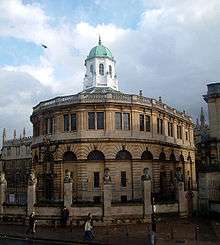
The university is a "city university" in that it does not have a main campus; instead, colleges, departments, accommodation, and other facilities are scattered throughout the city centre. The Science Area, in which most science departments are located, is the area that bears closest resemblance to a campus. The ten-acre (4-hectare) Radcliffe Observatory Quarter in the northwest of the city is currently under development. However, the larger colleges' sites are of similar size to these areas.
Iconic university buildings include the Radcliffe Camera, the Sheldonian Theatre used for music concerts, lectures, and university ceremonies, and the Examination Schools, where examinations and some lectures take place. The University Church of St Mary the Virgin was used for university ceremonies before the construction of the Sheldonian. Christ Church Cathedral uniquely serves as both a college chapel and as a cathedral.
In 2012–2013, the university built the controversial one-hectare (400m × 25m) Castle Mill development of 4–5-storey blocks of student flats overlooking Cripley Meadow and the historic Port Meadow, blocking views of the spires in the city centre.[75] The development has been likened to building a "skyscraper beside Stonehenge".[76]
Parks
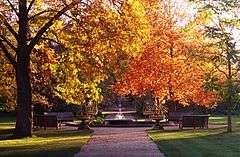
The University Parks are a 70-acre (28 ha) parkland area in the northeast of the city, near Keble College, Somerville College and Lady Margaret Hall. It is open to the public during daylight hours. As well as providing gardens and exotic plants, the Parks contains numerous sports fields, used for official and unofficial fixtures, and also contains sites of special interest including the Genetic Garden, an experimental garden to elucidate and investigate evolutionary processes.
The Botanic Garden on the High Street is the oldest botanic garden in the UK. It contains over 8,000 different plant species on 1.8 ha (4 1⁄2 acres). It is one of the most diverse yet compact major collections of plants in the world and includes representatives of over 90% of the higher plant families. The Harcourt Arboretum is a 130-acre (53 ha) site six miles (10 km) south of the city that includes native woodland and 67 acres (27 hectares) of meadow. The 1,000-acre (4.0 km2) Wytham Woods are owned by the university and used for research in zoology and climate change.
There are also various collegiate-owned open spaces open to the public, including Bagley Wood and most notably Christ Church Meadow.[77]
Organisation
As a collegiate university, Oxford's structure can be confusing to those unfamiliar with it. The university is a federation, comprising over forty self-governing colleges and halls, along with a central administration headed by the Vice-Chancellor.
Academic departments are located centrally within the structure of the federation; they are not affiliated with any particular college. Departments provide facilities for teaching and research, determine the syllabi and guidelines for the teaching of students, perform research, and deliver lectures and seminars.
Colleges arrange the tutorial teaching for their undergraduates, and the members of an academic department are spread around many colleges. Though certain colleges do have subject alignments (e.g., Nuffield College as a centre for the social sciences), these are exceptions, and most colleges will have a broad mix of academics and students from a diverse range of subjects. Facilities such as libraries are provided on all these levels: by the central university (the Bodleian), by the departments (individual departmental libraries, such as the English Faculty Library), and by colleges (each of which maintains a multi-discipline library for the use of its members).
Central governance
The university's formal head is the Chancellor, currently Lord Patten of Barnes, though as at most British universities, the Chancellor is a titular figure and is not involved with the day-to-day running of the university. The Chancellor is elected by the members of Convocation, a body comprising all graduates of the university, and holds office until death.[78]

The Vice-Chancellor, currently Louise Richardson,[4][5] is the de facto head of the university. Five pro-vice-chancellors have specific responsibilities for education; research; planning and resources; development and external affairs; and personnel and equal opportunities. The University Council is the executive policy-forming body, which consists of the vice-chancellor as well as heads of departments and other members elected by Congregation, in addition to observers from the students' union. Congregation, the "parliament of the dons", comprises over 3,700 members of the university's academic and administrative staff, and has ultimate responsibility for legislative matters: it discusses and pronounces on policies proposed by the University Council.
Two university proctors, elected annually on a rotating basis from two of the colleges, are the internal ombudsmen who make sure that the university and its members adhere to its statutes. This role incorporates student welfare and discipline, as well as oversight of the university's proceedings. The university's professors are collectively referred to as the Statutory Professors of the University of Oxford. They are particularly influential in the running of the university's graduate programmes. Examples of statutory professors are the Chichele Professorships and the Drummond Professor of Political Economy. The various academic faculties, departments, and institutes are organised into four divisions, each with its own head and elected board. They are the Humanities Division; the Social Sciences Division; the Mathematical, Physical and Life Sciences Division; and the Medical Sciences Division.
The University of Oxford is a "public university" in the sense that it receives some public money from the government, but it is a "private university" in the sense that it is entirely self-governing and, in theory, could choose to become entirely private by rejecting public funds.[79]
Colleges
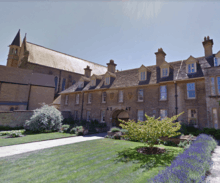
To be a member of the university, all students, and most academic staff, must also be a member of a college or hall. There are thirty-nine colleges of the University of Oxford (including Reuben College, planned to admit students in 2021)[80] and six permanent private halls (PPHs), each controlling its membership and with its own internal structure and activities.[13] Not all colleges offer all courses, but they generally cover a broad range of subjects.
The colleges are:
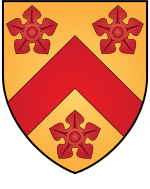

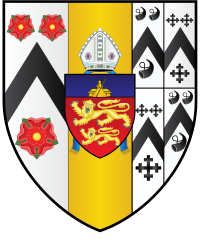

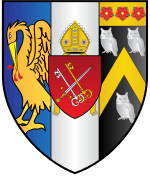

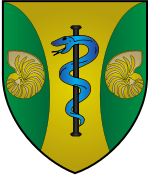





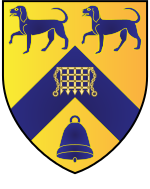
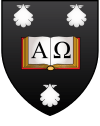
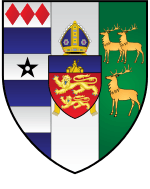

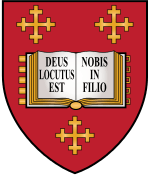

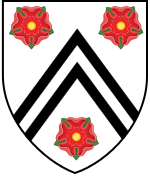
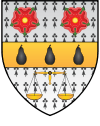

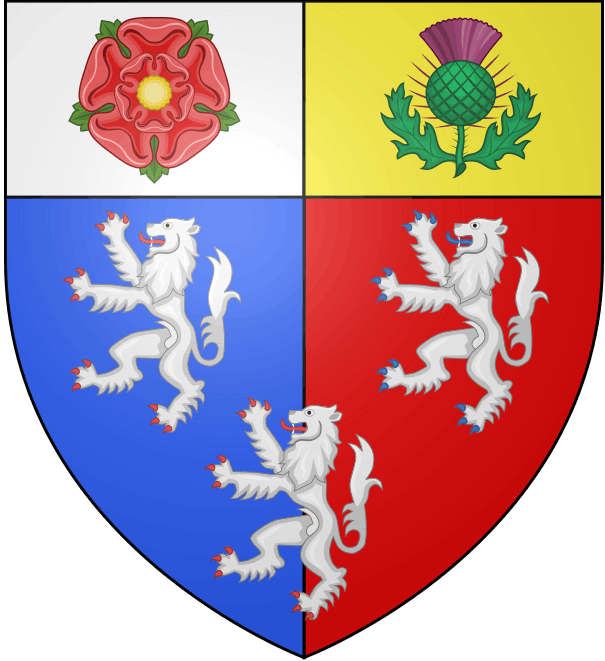
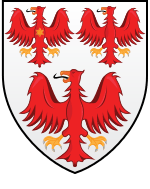

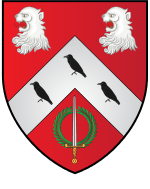
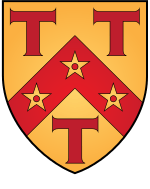




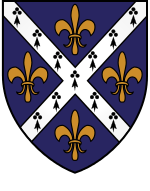







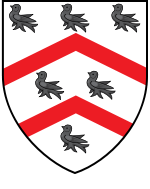
The permanent private halls were founded by different Christian denominations. One difference between a college and a PPH is that whereas colleges are governed by the fellows of the college, the governance of a PPH resides, at least in part, with the corresponding Christian denomination. The six current PPHs are:
The PPHs and colleges join together as the Conference of Colleges, which represents the common concerns of the several colleges of the university, to discuss matters of shared interest and to act collectively when necessary, such as in dealings with the central university.[81][82] The Conference of Colleges was established as a recommendation of the Franks Commission in 1965.[83]
Teaching members of the colleges (i.e. fellows and tutors) are collectively and familiarly known as dons, although the term is rarely used by the university itself. In addition to residential and dining facilities, the colleges provide social, cultural, and recreational activities for their members. Colleges have responsibility for admitting undergraduates and organising their tuition; for graduates, this responsibility falls upon the departments. There is no common title for the heads of colleges: the titles used include Warden, Provost, Principal, President, Rector, Master and Dean.
Finances
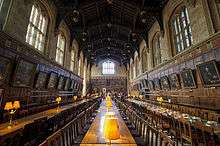
In 2017/18, the university had an income of £2,237m; key sources were research grants (£579.1m) and academic fees (£332.5m).[84] The colleges had a total income of £492.9m.[85]
While the university has a larger annual income and operating budget, the colleges have a larger aggregate endowment: over £4.9bn compared to the university's £1.2bn.[3] The central University's endowment, along with some of the colleges', is managed by the university's wholly owned endowment management office, Oxford University Endowment Management, formed in 2007.[86] The university has substantial investments in fossil fuel companies, and in 2014 began consultations on whether it should follow some US universities which have committed to sell off their fossil fuel investments.[87]
The total assets of the colleges of £6.3 billion also exceed total university assets of 4.1 billion.[85][84] The college figure does not reflect all the assets held by the colleges as their accounts do not include the cost or value of many of their main sites or heritage assets such as works of art or libraries.[88]
The university was one of the first in the UK to raise money through a major public fundraising campaign, the Campaign for Oxford. The current campaign, its second, was launched in May 2008 and is entitled "Oxford Thinking – The Campaign for the University of Oxford".[89] This is looking to support three areas: academic posts and programmes, student support, and buildings and infrastructure;[90] having passed its original target of £1.25 billion in March 2012, the target was raised to £3 billion.[91] The campaign had raised a total of £2.8 billion by July 2018.[84]
Affiliations
Oxford is a member of the Russell Group of research-led British universities, the G5, the League of European Research Universities, and the International Alliance of Research Universities. It is also a core member of the Europaeum and forms part of the "golden triangle" of highly research intensive and elite English universities.[92]
Academic profile
Admission
| 2019 | 2018 | 2017 | 2016 | 2015 | |
|---|---|---|---|---|---|
| Applications | 23,020 | 21,515 | 19,938 | 19,144 | 18,377 |
| Offer rate (%) | 16.9 | 17.8 | 18.9 | 19.6 | 19.9 |
| Yield (%) | 84.3 | 86.2 | 86.7 | 87.0 | 87.8 |
In common with most British universities, prospective students apply through the UCAS application system, but prospective applicants for the University of Oxford, along with those for medicine, dentistry, and University of Cambridge applicants, must observe an earlier deadline of 15 October.[96] The Sutton Trust maintains that Oxford University and Cambridge University recruit disproportionately from 8 schools which accounted for 1,310 Oxbridge places during three years, contrasted with 1,220 from 2,900 other schools.[97]
To allow a more personalised judgement of students, who might otherwise apply for both, undergraduate applicants are not permitted to apply to both Oxford and Cambridge in the same year. The only exceptions are applicants for organ scholarships[98] and those applying to read for a second undergraduate degree.[99] Oxford has the lowest offer rate of all Russell Group universities.[100]
Most applicants choose to apply to one of the individual colleges, which work with each other to ensure that the best students gain a place somewhere at the university regardless of their college preferences.[101] Shortlisting is based on achieved and predicted exam results, school references, and, in some subjects, written admission tests or candidate-submitted written work. Approximately 60% of applicants are shortlisted, although this varies by subject. If a large number of shortlisted applicants for a subject choose one college, then students who named that college may be reallocated randomly to under-subscribed colleges for the subject. The colleges then invite shortlisted candidates for interview, where they are provided with food and accommodation for around three days in December. Most applicants will be individually interviewed by academics at more than one college. Students from outside Europe can be interviewed remotely, for example, over the Internet.
Offers are sent out in early January, with each offer usually being from a specific college. One in four successful candidates receives an offer from a college that they did not apply to. Some courses may make "open offers" to some candidates, who are not assigned to a particular college until A Level results day in August.[102][103]
The university has come under criticism for the number of students it accepts from private schools;[104] for instance, Laura Spence's rejection from the university in 2000 led to widespread debate.[105] In 2016, the University of Oxford gave 59% of offers to UK students to students from state schools, while about 93% of all UK pupils and 86% of post-16 UK pupils are educated in state schools.[106][107][108] However, 64% of UK applicants were from state schools and the university notes that state school students apply disproportionately to oversubscribed subjects.[109] Oxford University spends over £6 million per year on outreach programs to encourage applicants from underrepresented demographics.[106]
In 2018 the university's annual admissions report revealed that eight of Oxford's colleges had accepted fewer than three black applicants in the past three years.[110] David Lammy said, "This is social apartheid and it is utterly unrepresentative of life in modern Britain."[111]
Teaching and degrees
Undergraduate teaching is centred on the tutorial, where 1–4 students spend an hour with an academic discussing their week's work, usually an essay (humanities, most social sciences, some mathematical, physical, and life sciences) or problem sheet (most mathematical, physical, and life sciences, and some social sciences). The university itself is responsible for conducting examinations and conferring degrees. Undergraduate teaching takes place during three eight-week academic terms: Michaelmas, Hilary and Trinity.[112] (These are officially known as 'Full Term': 'Term' is a lengthier period with little practical significance.) Internally, the weeks in a term begin on Sundays, and are referred to numerically, with the initial week known as "first week", the last as "eighth week" and with the numbering extended to refer to weeks before and after term (for example "-1st week" and "0th week" precede term). Undergraduates must be in residence from Thursday of 0th week. These teaching terms are shorter than those of most other British universities,[113] and their total duration amounts to less than half the year. However, undergraduates are also expected to do some academic work during the three holidays (known as the Christmas, Easter, and Long Vacations).
Research degrees at the master's and doctoral level are conferred in all subjects studied at graduate level at the university.
Scholarships and financial support
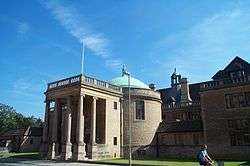
There are many opportunities for students at Oxford to receive financial help during their studies. The Oxford Opportunity Bursaries, introduced in 2006, are university-wide means-based bursaries available to any British undergraduate, with a total possible grant of £10,235 over a 3-year degree. In addition, individual colleges also offer bursaries and funds to help their students. For graduate study, there are many scholarships attached to the university, available to students from all sorts of backgrounds, from Rhodes Scholarships to the relatively new Weidenfeld Scholarships.[114] Oxford also offers the Clarendon Scholarship which is open to graduate applicants of all nationalities.[115] The Clarendon Scholarship is principally funded by Oxford University Press in association with colleges and other partnership awards.[116][117] In 2016, Oxford University announced that it is to run its first free online economics course as part of a "massive open online course" (Mooc) scheme, in partnership with a US online university network.[118] The course available is called ‘From Poverty to Prosperity: Understanding Economic Development’.
Students successful in early examinations are rewarded by their colleges with scholarships and exhibitions, normally the result of a long-standing endowment, although since the introduction of tuition fees the amounts of money available are purely nominal. Scholars, and exhibitioners in some colleges, are entitled to wear a more voluminous undergraduate gown; "commoners" (originally those who had to pay for their "commons", or food and lodging) are restricted to a short, sleeveless garment. The term "scholar" in relation to Oxford therefore has a specific meaning as well as the more general meaning of someone of outstanding academic ability. In previous times, there were "noblemen commoners" and "gentlemen commoners", but these ranks were abolished in the 19th century. "Closed" scholarships, available only to candidates who fitted specific conditions such as coming from specific schools, were abolished in the 1970s and 1980s.[119]
Libraries
The university maintains the largest university library system in the UK,[15] and, with over 11 million volumes housed on 120 miles (190 km) of shelving, the Bodleian group is the second-largest library in the UK, after the British Library. The Bodleian is a legal deposit library, which means that it is entitled to request a free copy of every book published in the UK. As such, its collection is growing at a rate of over three miles (five kilometres) of shelving every year.[120]
The buildings referred to as the university's main research library, The Bodleian, consist of the original Bodleian Library in the Old Schools Quadrangle, founded by Sir Thomas Bodley in 1598 and opened in 1602,[121] the Radcliffe Camera, the Clarendon Building, and the Weston Library. A tunnel underneath Broad Street connects these buildings, with the Gladstone Link, which opened to readers in 2011, connecting the Old Bodleian and Radcliffe Camera.
.jpg)
The Bodleian Libraries group was formed in 2000, bringing the Bodleian Library and some of the subject libraries together.[122] It now comprises 28[123] libraries, a number of which have been created by bringing previously separate collections together, including the Sackler Library, Social Science Library and Radcliffe Science Library.[122] Another major product of this collaboration has been a joint integrated library system, OLIS (Oxford Libraries Information System),[124] and its public interface, SOLO (Search Oxford Libraries Online), which provides an electronic catalogue covering all member libraries, as well as the libraries of individual colleges and other faculty libraries, which are not members of the group but do share cataloguing information.[125]
A new book depository opened in South Marston, Swindon in October 2010,[126] and recent building projects include the remodelling of the New Bodleian building, which was renamed the Weston Library when it reopened in 2015.[127][128] The renovation is designed to better showcase the library's various treasures (which include a Shakespeare First Folio and a Gutenberg Bible) as well as temporary exhibitions.
The Bodleian engaged in a mass-digitisation project with Google in 2004.[129][130] Notable electronic resources hosted by the Bodleian Group include the Electronic Enlightenment Project, which was awarded the 2010 Digital Prize by the British Society for Eighteenth-Century Studies.[131]
Museums
Oxford maintains a number of museums and galleries, open for free to the public. The Ashmolean Museum, founded in 1683, is the oldest museum in the UK, and the oldest university museum in the world.[132] It holds significant collections of art and archaeology, including works by Michelangelo, Leonardo da Vinci, Turner, and Picasso, as well as treasures such as the Scorpion Macehead, the Parian Marble and the Alfred Jewel. It also contains "The Messiah", a pristine Stradivarius violin, regarded by some as one of the finest examples in existence.
The University Museum of Natural History holds the university's zoological, entomological and geological specimens. It is housed in a large neo-Gothic building on Parks Road, in the university's Science Area.[133][134] Among its collection are the skeletons of a Tyrannosaurus rex and Triceratops, and the most complete remains of a dodo found anywhere in the world. It also hosts the Simonyi Professorship of the Public Understanding of Science, currently held by Marcus du Sautoy.
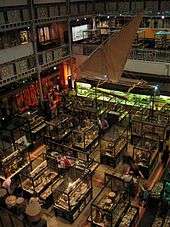
Adjoining the Museum of Natural History is the Pitt Rivers Museum, founded in 1884, which displays the university's archaeological and anthropological collections, currently holding over 500,000 items. It recently built a new research annexe; its staff have been involved with the teaching of anthropology at Oxford since its foundation, when as part of his donation General Augustus Pitt Rivers stipulated that the university establish a lectureship in anthropology.
The Museum of the History of Science is housed on Broad Street in the world's oldest-surviving purpose-built museum building.[135] It contains 15,000 artefacts, from antiquity to the 20th century, representing almost all aspects of the history of science. In the Faculty of Music on St Aldate's is the Bate Collection of Musical Instruments, a collection mostly of instruments from Western classical music, from the medieval period onwards. Christ Church Picture Gallery holds a collection of over 200 old master paintings.
Publishing
The Oxford University Press is the world's second oldest and currently the largest university press by the number of publications.[14] More than 6,000 new books are published annually,[136] including many reference, professional, and academic works (such as the Oxford English Dictionary, the Concise Oxford English Dictionary, the Oxford World's Classics, the Oxford Dictionary of National Biography, and the Concise Dictionary of National Biography).
Rankings and reputation
| National rankings | |
|---|---|
| Complete (2021)[137] | 2 |
| Guardian (2020)[138] | 3 |
| Times / Sunday Times (2020)[139] | 2 |
| Global rankings | |
| ARWU (2019)[140] | 7 |
| QS (2020)[141] | 4 |
| THE (2020)[142] | 1 |
| British Government assessment | |
| Teaching Excellence Framework[143] | Gold |
Oxford is regularly ranked within the top 5 universities in the world and is currently ranked first in the world in the Times Higher Education World University Rankings,[144][145] as well as the Forbes's World University Rankings.[146] It held the number one position in the Times Good University Guide for eleven consecutive years,[147] and the medical school has also maintained first place in the "Clinical, Pre-Clinical & Health" table of the Times Higher Education (THE) World University Rankings for the past seven consecutive years.[148] In 2019, it ranked 7th among the universities around the world by SCImago Institutions Rankings.[149] The THE has also recognised Oxford as one of the world's "six super brands" on its World Reputation Rankings, along with Berkeley, Cambridge, Harvard, MIT, and Stanford.[150] The university is fifth worldwide on the US News ranking.[151] Its Saïd Business School came 13th in the world in Financial Times Global MBA Ranking.[152]
Oxford was ranked ninth in the world in 2015 by the Nature Index, which measures the largest contributors to papers published in 82 leading journals.[153][154] It is ranked 5th best university worldwide and 1st in Britain for forming CEOs according to the Professional Ranking World Universities,[155] and first in the UK for the quality of its graduates as chosen by the recruiters of the UK's major companies.[156]
In the 2018 Complete University Guide, all 38 subjects offered by Oxford rank within the top 10 nationally meaning Oxford was one of only two multi-faculty universities (along with Cambridge) in the UK to have 100% of their subjects in the top 10.[157] Computer Science, Medicine, Philosophy, Politics and Psychology were ranked first in the UK by the guide.[158]
According to the QS World University Rankings by Subject, the University of Oxford also ranks as number one in the world for four Humanities disciplines: English Language and Literature, Modern Languages, Geography, and History. It also ranks 2nd globally for Anthropology, Archaeology, Law, Medicine, Politics & International Studies, and Psychology.[159]
Sexual harassment accusations
In 2015, a half-dozen students filed a complaint through sexual harassment attorney and Oxford alumna Ann Olivarius against Oxford for what The Times called an “epidemic” of sexual misconduct.[160][161] Oxford has also been accused of using non-disclosure agreements or ‘gagging orders’ to silence students who report sexual harassment.[162] In 2020, it was reported that Oxford saw a 15-fold increase in sexual harassment and violence.[163]
Student life
Traditions
Academic dress is required for examinations, matriculation, disciplinary hearings, and when visiting university officers. A referendum held amongst the Oxford student body in 2015 showed 76% against making it voluntary in examinations – 8,671 students voted, with the 40.2% turnout the highest ever for a UK student union referendum.[164] This was widely interpreted by students as being a vote on not so much making subfusc voluntary, but rather, in effect, abolishing it by default, in that if a minority of people came to exams without subfusc, the rest would soon follow.[165] In July 2012 the regulations regarding academic dress were modified to be more inclusive to transgender people.[166]
Other traditions and customs vary by college. For example, some colleges have formal hall six times a week, but in others this only happens occasionally. At most colleges these formal meals require gowns to be worn, and a Latin grace is said.
Balls are major events held by colleges; the largest, held triennially in 9th week of Trinity Term, are called commemoration balls; the dress code is usually white tie. Many other colleges hold smaller events during the year that they call summer balls or parties. These are usually held on an annual or irregular basis, and are usually black tie.
Punting is a common summer leisure activity.
There are several more or less quirky traditions peculiar to individual colleges, for example the All Souls Mallard song.
Clubs and societies
Sport is played between college teams, in tournaments known as cuppers (the term is also used for some non-sporting competitions). In addition to these there are higher standard university wide groups. Significant focus is given to annual varsity matches played against Cambridge, the most famous of which is The Boat Race, watched by a TV audience of between five and ten million viewers. This outside interest reflects the importance of rowing to many of those within the university. Much attention is given to the termly intercollegiate rowing regattas: Christ Church Regatta, Torpids and Summer Eights. A blue is an award given to those who compete at the university team level in certain sports. As well as traditional sports, there are teams for activities such as Octopush and quidditch.
There are two weekly student newspapers: the independent Cherwell and OUSU's The Oxford Student. Other publications include the Isis magazine, the satirical Oxymoron, and the graduate Oxonian Review. The student radio station is Oxide Radio. Most colleges have chapel choirs. Music, drama, and other arts societies exist both at collegiate level and as university-wide groups, such as Oxford University Dramatic Society and the Oxford Revue. Unlike most other collegiate societies, musical ensembles actively encourage players from other colleges.
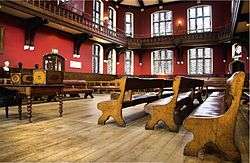
Most academic areas have student societies of some form which are open to students studying all courses, for example the Scientific Society. There are groups for almost all faiths, political parties, countries and cultures.
The Oxford Union (not to be confused with the Oxford University Student Union) hosts weekly debates and high-profile speakers. There have historically been elite invite-only societies such as the Bullingdon Club.
Student union and common rooms
The Oxford University Student Union, formerly better known by its acronym OUSU and now rebranded as Oxford SU,[167] exists to represent students in the university's decision-making, to act as the voice for students in the national higher education policy debate, and to provide direct services to the student body. Reflecting the collegiate nature of the University of Oxford itself, OUSU is both an association of Oxford's more than 21,000 individual students and a federation of the affiliated college common rooms, and other affiliated organisations that represent subsets of the undergraduate and graduate students. The OUSU Executive Committee includes six full-time salaried sabbatical officers, who generally serve in the year following completion of their Final Examinations.
The importance of collegiate life is such that for many students their college JCR (Junior Common Room, for undergraduates) or MCR (Middle Common Room, for graduates) is seen as more important than OUSU. JCRs and MCRs each have a committee, with a president and other elected students representing their peers to college authorities. Additionally, they organise events and often have significant budgets to spend as they wish (money coming from their colleges and sometimes other sources such as student-run bars). (It is worth noting that JCR and MCR are terms that are used to refer to rooms for use by members, as well as the student bodies.) Not all colleges use this JCR/MCR structure, for example Wadham College's entire student population is represented by a combined Students' Union and purely graduate colleges have different arrangements.
Notable alumni
Throughout its history, a sizeable number of Oxford alumni, known as Oxonians, have become notable in many varied fields, both academic and otherwise. A total of 69 Nobel prize-winners have studied or taught at Oxford, with prizes won in all six categories.[16] More information on notable members of the university can be found in the individual college articles. An individual may be associated with two or more colleges, as an undergraduate, postgraduate and/or member of staff.
Politics
Twenty-eight British prime ministers have attended Oxford, including William Gladstone, H. H. Asquith, Clement Attlee, Harold Macmillan, Edward Heath, Harold Wilson, Margaret Thatcher, Tony Blair, David Cameron, Theresa May and Boris Johnson. Of all the post-war prime ministers, only Gordon Brown was educated at a university other than Oxford (the University of Edinburgh), while James Callaghan and John Major never attended a university.[168]
Over 100 Oxford alumni were elected to the House of Commons in 2010.[168] This includes former Leader of the Opposition, Ed Miliband, and numerous members of the cabinet and shadow cabinet. Additionally, over 140 Oxonians sit in the House of Lords.[16]
At least 30 other international leaders have been educated at Oxford.[16] This number includes Harald V of Norway,[169] Abdullah II of Jordan,[16] William II of the Netherlands, five Prime Ministers of Australia (John Gorton, Malcolm Fraser, Bob Hawke, Tony Abbott, and Malcolm Turnbull),[170][171][172] Six Prime Ministers of Pakistan (Liaquat Ali Khan, Huseyn Shaheed Suhrawardy, Sir Feroz Khan Noon, Zulfiqar Ali Bhutto, Benazir Bhutto and Imran Khan),[16] two Prime Ministers of Canada (Lester B. Pearson and John Turner),[16][173] two Prime Ministers of India (Manmohan Singh and Indira Gandhi, though the latter did not finish her degree),[16][174] Prime Minister of Ceylon (S. W. R. D. Bandaranaike), Norman Washington Manley of Jamaica,[175] Haitham bin Tariq Al Said (Sultan of Oman)[176] Eric Williams (Prime Minister of Trinidad and Tobago), Pedro Pablo Kuczynski (former President of Peru), Abhisit Vejjajiva (former Prime Minister of Thailand), and Bill Clinton (the first President of the United States to have attended Oxford; he attended as a Rhodes Scholar).[16][177] Arthur Mutambara (Deputy Prime Minister of Zimbabwe), was a Rhodes Scholar in 1991. Seretse Khama, first president of Botswana, spent a year at Balliol College. Festus Mogae (former president of Botswana) was a student at University College. The Burmese democracy activist and Nobel laureate, Aung San Suu Kyi, was a student of St Hugh's College.[178] Jigme Khesar Namgyel Wangchuck, the current reigning Druk Gyalpo (Dragon King) of Bhutan, was a member of St Peter's College.[179]
Law
Oxford has produced a large number of distinguished jurists, judges and lawyers around the world. Lords Bingham and Denning, commonly recognised as two of the most influential English judges in the history of the common law,[180][181][182][183] both studied at Oxford. Within the United Kingdom, three of the current Justices of the Supreme Court are Oxford-educated: Robert Reed (Deputy President of the Supreme Court), Nicholas Wilson, and Michael Briggs;[184] retired Justices include David Neuberger (President of the Supreme Court 2012–2017), Jonathan Mance (Deputy President of the Supreme Court 2017–2018), Alan Rodger, Jonathan Sumption, Mark Saville, John Dyson, and Simon Brown. The twelve Lord Chancellors and nine Lord Chief Justices that have been educated at Oxford include Thomas Bingham,[180] Stanley Buckmaster, Thomas More,[185] Thomas Wolsey,[186] Gavin Simonds.[187] The twenty-two Law Lords count amongst them Leonard Hoffmann, Kenneth Diplock, Richard Wilberforce, James Atkin, Simon Brown, Nicolas Browne-Wilkinson, Robert Goff, Brian Hutton, Jonathan Mance, Alan Rodger, Mark Saville, Leslie Scarman, Johan Steyn;[188] Master of the Rolls include Alfred Denning and Wilfred Greene;[183] Lord Justices of Appeal include John Laws, Brian Leveson and John Mummery. The British Government's Attorneys General have included Dominic Grieve, Nicholas Lyell, Patrick Mayhew, John Hobson, Reginald Manningham-Buller, Lionel Heald, Frank Soskice, David Maxwell Fyfe, Donald Somervell, William Jowitt; Directors of Public Prosecutions include Sir Thomas Hetherington QC, Dame Barbara Mills QC and Sir Keir Starmer QC.
In the United States, three of the nine incumbent Justices of the Supreme Court are Oxonians, namely Stephen Breyer,[189] Elena Kagan,[190] and Neil Gorsuch;[191] retired Justices include John Marshall Harlan II,[192] David Souter[193] and Byron White.[194] Internationally, Oxonians Sir Humphrey Waldock[195] served in the International Court of Justice; Akua Kuenyehia, sat in the International Criminal Court; Sir Nicolas Bratza[196] and Paul Mahoney sat in the European Court of Human Rights; Kenneth Hayne,[197] Dyson Heydon, as well as Patrick Keane sat in the High Court of Australia; both Kailas Nath Wanchoo, A. N. Ray served as Chief Justices of the Supreme Court of India; Cornelia Sorabji, Oxford's first female law student, was India's first female advocate; in Hong Kong, Aarif Barma, Thomas Au and Doreen Le Pichon[198] currently serve in the Court of Appeal (Hong Kong), while Charles Ching and Henry Litton both served as Permanent Judges of the Court of Final Appeal of Hong Kong;[199] six Puisne Justices of the Supreme Court of Canada and a chief justice of the now defunct Federal Court of Canada were also educated at Oxford.
The list of noted legal scholars includes H. L. A. Hart,[200] Ronald Dworkin,[200] Andrew Burrows, Sir Guenter Treitel, Jeremy Waldron, A. V. Dicey, William Blackstone, John Gardner, Robert A. Gorman, Timothy Endicott, Peter Birks, John Finnis, Andrew Ashworth, Joseph Raz, Paul Craig, Leslie Green, Tony Honoré, Neil MacCormick and Hugh Collins. Other distinguished practitioners who have attended Oxford include Lord Pannick Qc,[201] Geoffrey Robertson QC, Amal Clooney,[202] Lord Faulks QC, and Dinah Rose QC.
Mathematics and sciences
Three Oxford mathematicians, Michael Atiyah, Daniel Quillen and Simon Donaldson, have won Fields Medals, often called the "Nobel Prize for mathematics". Andrew Wiles, who proved Fermat's Last Theorem, was educated at Oxford and is currently the Regius Professor and Royal Society Research Professor in Mathematics at Oxford.[203] Marcus du Sautoy and Roger Penrose are both currently mathematics professors, and Jackie Stedall was a professor of the university. Stephen Wolfram, chief designer of Mathematica and Wolfram Alpha studied at the university, along with Tim Berners-Lee,[16] inventor of the World Wide Web,[204] Edgar F. Codd, inventor of the relational model of data,[205] and Tony Hoare, programming languages pioneer and inventor of Quicksort.
The university is associated with eleven winners of the Nobel Prize in Chemistry, five in physics and sixteen in medicine.[206]
Scientists who performed research in Oxford include chemist Dorothy Hodgkin who received her Nobel Prize for "determinations by X-ray techniques of the structures of important biochemical substances",[207] Howard Florey who shared the 1945 Nobel prize "for the discovery of penicillin and its curative effect in various infectious diseases", and John B. Goodenough, who shared the Nobel Prize in Chemistry in 2019 "for the development of lithium-ion batteries".[208] Both Richard Dawkins[209] and Frederick Soddy[210] studied at the university and returned for research purposes. Robert Hooke,[16] Edwin Hubble,[16] and Stephen Hawking[16] all studied in Oxford.
Robert Boyle, a founder of modern chemistry, never formally studied or held a post within the university, but resided within the city to be part of the scientific community and was awarded an honorary degree.[211] Notable scientists who spent brief periods at Oxford include Albert Einstein[212] developer of general theory of relativity and the concept of photons; and Erwin Schrödinger who formulated the Schrödinger equation and the Schrödinger's cat thought experiment. Structural engineer Roma Agrawal, responsible for London's Shard, attributes her love of engineering to a summer placement during her undergraduate physics degree at Oxford.
Economists Adam Smith, Alfred Marshall, E. F. Schumacher, and Amartya Sen all spent time at Oxford.
Literature, music, and drama
Writers associated with Oxford include Vera Brittain, A.S. Byatt, Lewis Carroll,[213] Penelope Fitzgerald, John Fowles, Theodor Geisel, Robert Graves, Graham Greene,[214] Joseph Heller,[215] Christopher Hitchens, Aldous Huxley,[216] Samuel Johnson, C. S. Lewis,[217] Thomas Middleton, Iris Murdoch, V.S. Naipaul, Philip Pullman,[16] Dorothy L. Sayers, Vikram Seth,[16] J. R. R. Tolkien,[218] Evelyn Waugh,[219] Oscar Wilde,[220] the poets Percy Bysshe Shelley,[221] John Donne,[222] A. E. Housman,[223] Gerard Manley Hopkins, W. H. Auden,[224] T. S. Eliot, Wendy Perriam and Philip Larkin,[225] and seven poets laureate: Thomas Warton,[226] Henry James Pye,[227] Robert Southey,[228] Robert Bridges,[229] Cecil Day-Lewis,[230] Sir John Betjeman,[231] and Andrew Motion.[232]
Composers Hubert Parry, George Butterworth, John Taverner, William Walton, James Whitbourn and Andrew Lloyd Webber have all been involved with the university.
Actors Hugh Grant,[233] Kate Beckinsale,[233] Rosamund Pike, Felicity Jones, Gemma Chan, Dudley Moore,[234] Michael Palin,[16] Terry Jones,[235] Anna Popplewell and Rowan Atkinson were students at the university, as were filmmakers Ken Loach[236] and Richard Curtis.[16]
Religion
Oxford has also produced at least 12 saints, 19 English cardinals, and 20 Archbishops of Canterbury, the most recent Archbishop being Rowan Williams, who studied at Wadham College and was later a Canon Professor at Christ Church.[16][237] Duns Scotus' teaching is commemorated with a monument in the University Church of St. Mary. Religious reformer John Wycliffe was an Oxford scholar, for a time Master of Balliol College. John Colet, Christian humanist, Dean of St Paul's, and friend of Erasmus, studied at Magdalen College. Several of the Caroline Divines e.g. in particular William Laud as President of St. John's and Chancellor of the University, and the Non-Jurors, e.g. Thomas Ken had close Oxford connections. The founder of Methodism, John Wesley, studied at Christ Church and was elected a fellow of Lincoln College.[238] Britain's first woman to be an ordained minister, Constance Coltman, studied at Somerville College. The Oxford Movement (1833–1846) was closely associated with the Oriel fellows John Henry Newman, Edward Bouverie Pusey and John Keble. Other religious figures were Mirza Nasir Ahmad, the third Caliph of the Ahmadiyya Muslim Community, Shoghi Effendi, one of the appointed leaders of the Baha'i faith and Joseph Cordeiro, the only Pakistani Catholic cardinal.[239]
Philosophy
Oxford's philosophical tradition started in the medieval era, with Robert Grosseteste[240] and William of Ockham,[240] commonly known for Occam's razor, among those teaching at the university. Thomas Hobbes,[241][242] Jeremy Bentham and the empiricist John Locke received degrees from Oxford. Though the latter's main works were written after leaving Oxford, Locke was heavily influenced by his twelve years at the university.[240]
Oxford philosophers of the 20th century include J.L. Austin, a leading proponent of ordinary-language philosophy, Gilbert Ryle,[240] author of The Concept of Mind, and Derek Parfit, who specialised in personal identity. Other commonly read modern philosophers to have studied at the university include A. J. Ayer,[240] Elizabeth Anscombe, Paul Grice, Mary Midgley, Iris Murdoch, Thomas Nagel, Bernard Williams, Robert Nozick, Onora O'Neill, John Rawls, Michael Sandel, and Peter Singer. John Searle, presenter of the Chinese room thought experiment, studied and began his academic career at the university.[243] Likewise, Philippa Foot, who mentioned the trolley problem, studied and taught at Oxford.[244]
Sport
Sir Roger Gilbert Bannister, who had been at Exeter College and Merton College, ran the first sub-four-minute mile in Oxford.
Some 150 Olympic medal-winners have academic connections with the university, including Sir Matthew Pinsent, quadruple gold-medallist rower.[16][245]
Rowers from Oxford who have won gold at the Olympics or World Championships include Michael Blomquist, Ed Coode, Chris Davidge, Hugh Edwards, Jason Flickinger, Tim Foster, Luka Grubor, Christopher Liwski, Matthew Pinsent, Pete Reed, Jonny Searle, Andrew Triggs Hodge, Jake Wetzel, Michael Wherley, and Barney Williams. Many Oxford graduates have also risen to the highest echelon in cricket: Harry Altham, Bernard Bosanquet (inventor of the googly), Colin Cowdrey, Gerry Crutchley, Jamie Dalrymple, Martin Donnelly, R. E. Foster (the only man to captain England at both cricket and football), C. B. Fry, George Harris (also served in the House of Lords), Douglas Jardine, Malcolm Jardine, Imran Khan, Sophie Le Marchand, Alan Melville, Iftikhar Ali Khan Pataudi, Mansoor Ali Khan Pataudi, M. J. K. Smith, and Pelham Warner.
Oxford students have also excelled in other sports. Such alumni include American football player Myron Rolle (NFL player); Olympic gold medalists in athletics David Hemery and Jack Lovelock; basketball players Bill Bradley (US Senator and NBA player) and Charles Thomas McMillen (US Congressman and NBA player); figure skater John Misha Petkevich (national champion); footballers John Bain, Charles Wreford-Brown, and Cuthbert Ottaway; fencer Allan Jay (world champion and five-time Olympian); modern pentathlete Steph Cook (Olympic gold medalist); rugby footballers Stuart Barnes, Simon Danielli, David Humphreys, David Edward Kirk, Anton Oliver, Ronald Poulton-Palmer, Joe Roff, and William Webb Ellis (allegedly the inventor of rugby football); World Cup freestyle skier Ryan Max Riley (national champion); polo player Claire Tomlinson (highest ranked woman world-wide); and tennis player Clarence Bruce.
Adventure and exploration
Three of the most well-known adventurers and explorers who attended Oxford are Walter Raleigh, one of the most notable figures of the Elizabethan era, T. E. Lawrence, whose life was the basis of the 1962 film Lawrence of Arabia, and Thomas Coryat. The latter, the author of "Coryat's Crudities hastily gobbled up in Five Months Travels in France, Italy, &c'" (1611) and court jester of Henry Frederick, Prince of Wales, is credited with introducing the table fork and umbrella to England and being the first Briton to do a Grand Tour of Europe.[246]
Other notable figures include Gertrude Bell, an explorer, archaeologist, mapper and spy, who, along with T. E. Lawrence, helped establish the Hashemite dynasties in what is today Jordan and Iraq and played a major role in establishing and administering the modern state of Iraq; Richard Francis Burton, who travelled in disguise to Mecca and journeyed with John Hanning Speke as the first European explorers to visit the Great Lakes of Africa in search of the source of the Nile; anthropologist Katherine Routledge, who carried out the first survey of Easter Island; mountaineer Tom Bourdillon, member of the expedition to make the first ascent of Mount Everest; and Peter Fleming, adventurer and travel writer and elder brother of Ian Fleming, creator of James Bond.
Oxford in literature and other media
The University of Oxford is the setting for numerous works of fiction. Oxford was mentioned in fiction as early as 1400 when Chaucer in his Canterbury Tales referred to a "Clerk [student] of Oxenford". By 1989, 533 novels based in Oxford had been identified and the number continues to rise.[247] Famous literary works range from Brideshead Revisited by Evelyn Waugh, which in 1981 was adapted as a television serial, to the trilogy His Dark Materials by Philip Pullman, which features an alternate-reality version of the university and was adapted for film in 2007 and as a BBC television series in 2019.
Other notable examples include:
- Zuleika Dobson (1911) by Max Beerbohm, a satire about undergraduate life.
- Sinister Street (1913–1914) by Compton MacKenzie, himself a graduate of Magdalen College, a Bildungsroman about two children born out of wedlock.
- Gaudy Night (1935) by Dorothy L. Sayers, herself a graduate of Somerville College, a Lord Peter Wimsey mystery novel.
- The Inspector Morse detective novels (1975-1999) by Colin Dexter, adapted for television as Inspector Morse (1987–2000), the spin-off Lewis (2006–2015), and the prequel Endeavour (2012–).
- True Blue (1996), a film about the mutiny at the time of the Oxford-Cambridge Boat Race of 1987
- The History Boys (2004) by Alan Bennett, alumnus of Exeter College, a play about a group of grammar school boys in Sheffield in 1983 applying to read history at Oxford and Cambridge. It premiered at the National Theatre and was adapted for film in 2006.
- Posh (2010), a play by Laura Wade, and its film adaptation The Riot Club (2014), about a fictionalised equivalent of the Bullingdon Club.
- Testament of Youth (2014), a drama film based on the memoir of the same name written by Somerville alumna Vera Brittain.
Notable non-fiction works on Oxford include Oxford by Jan Morris.[248]
The university is parodied in Terry Pratchett's Discworld series with "Unseen University" and "Brazeneck College" (in reference to Brasenose College).
See also
- Academic scarves of the University of Oxford
- Gaudy celebrations
- List of medieval universities
- May Morning celebration
- Oxford "-er"
- Oxford bags
- Oxford comma
- Oxford Standard for Citation of Legal Authorities (OSCOLA)
- Oxford University (UK Parliament constituency)
- Oxford University Police
- Town and gown
Notes
References
Citations
- "The University as a charity". University of Oxford. Archived from the original on 12 January 2016.
- "Introduction and History". University of Oxford. Archived from the original on 20 October 2014. Retrieved 21 October 2014.
- "Finance and funding". ox.ac.uk. Retrieved 3 April 2020.
- "Declaration of approval of the appointment of a new Vice-Chancellor". Oxford University Gazette. University of Oxford. 25 June 2015. p. 659. Archived from the original on 30 June 2015. Retrieved 28 June 2015.
- "New Vice-Chancellor pledges 'innovative, creative' future for Oxford". News and Events. University of Oxford. 4 January 2016. Archived from the original on 7 January 2016. Retrieved 6 January 2016.
- https://www.ox.ac.uk/about/facts-and-figures/full-version-facts-and-figures?wssl=1
- https://public.tableau.com/views/UniversityofOxford-StudentStatistics/AtaGlance?:embed=y&:display_count=yes&:showVizHome=no
- "Student Numbers". University of Oxford. University of Oxford. Archived from the original on 15 September 2017. Retrieved 2 September 2019.
- "The brand colour – Oxford blue". Ox.ac.uk. Archived from the original on 24 May 2013. Retrieved 16 August 2013.
- Sager, Peter (2005). Oxford and Cambridge: An Uncommon History. p. 36.
- "Early records". University of Cambridge. 28 January 2013. Archived from the original on 11 October 2013. Retrieved 10 October 2013.
- "Oxford divisions". University of Oxford. Archived from the original on 20 October 2013. Retrieved 26 November 2013.
- "Colleges and Halls A-Z". University of Oxford. Archived from the original on 25 August 2011. Retrieved 4 October 2008.
- Balter, Michael (16 February 1994). "400 Years Later, Oxford Press Thrives". The New York Times. Archived from the original on 24 September 2011. Retrieved 28 June 2011.
- "Libraries". University of Oxford. Archived from the original on 25 November 2012.
- "Famous Oxonians". University of Oxford. 30 October 2007. Archived from the original on 7 June 2014. Retrieved 13 June 2014.
- "Oxford at the Olympics". University of Oxford. Archived from the original on 26 May 2019. Retrieved 26 August 2018.
- "Rhodes Scholarships". rhodeshouse.ox.ac.uk. Archived from the original on 19 October 2012. Retrieved 25 July 2010.
- "Preface: Constitution and Statute-making Powers of the University". University of Oxford. Archived from the original on 4 January 2014. Retrieved 4 January 2014.
- Adolphus Ballard, James Tait. (2010.) British Borough Charters 1216–1307 Archived 1 January 2016 at the Wayback Machine, Cambridge University Press, 222.
- Davies, Mark (4 November 2010). "'To lick a Lord and thrash a cad': Oxford 'Town & Gown'". BBC News. BBC. Archived from the original on 4 January 2014. Retrieved 3 January 2014.
- H. E. Salter; Mary D. Lobel, eds. (1954). "The University of Oxford". A History of the County of Oxford: Volume 3: The University of Oxford. Institute of Historical Research. Archived from the original on 16 January 2014. Retrieved 15 January 2014.
- H. Rashdall, Universities of Europe, iii, 55–60.
- Christopher Brooke, Roger Highfield. Oxford and Cambridge.
- Edward France Percival. The Foundation Statutes of Merton College, Oxford.
- White, Henry Julian (1906). Merton College, Oxford.
- Martin, G. H.; Highfield, J. R. L. (1997). A history of Merton College, Oxford.
- McKisack, May (1963). The Fourteenth Century 1307–1399. Oxford History of England. p. 501.
- Daniel J. Boorstin. (1958.) The Americans; the Colonial Experience, Vintage, pp. 171–184 Archived 24 June 2010 at the Wayback Machine.
- Christopher Nugent Lawrence Brooke. (1988.) Oxford and Cambridge, Cambridge University Press, Cambridge, p. 56.
- "Early Modern Ireland, 1534–1691", editors: T. W. Moody, Theodore William Moody, Francis X. Martin, Francis John Byrne, Oxford University Press (1991), p. 618, ISBN 9780198202424
- "Statutes of the University of Oxford, 2012–13" (PDF). Archived (PDF) from the original on 22 February 2018. Retrieved 31 January 2018.
- "Universities Tests Act 1871". UK Parliament. Archived from the original on 1 January 2016. Retrieved 30 December 2015.
- "Civil War: Surrender of Oxford". Oxfordshire Blue Plaques Scheme. Oxfordshire Blue Plaques Board. 2013. Retrieved 30 December 2015.
- Sir Spencer Walpole (1903). History of Twenty-Five Years: vol 4: 1870–1875. pp. 136–37. Archived from the original on 4 March 2017. Retrieved 3 March 2017.
- Walpole History of Twenty-Five Years: vol 3: 1870–1875 p.140
- William D. Rubinstein, "The social origins and career patterns of Oxford and Cambridge matriculants, 1840–1900." Historical Research 82.218 (2009): 715–730, data on pages 719 and 724.
- For more details see Mark C. Curthoys, "Origins and Destinations: the social mobility of Oxford men and women" in Michael G. Brock and Mark C. Curthoys, eds. The History of the University of Oxford Volume 7: Nineteenth-Century (2000) part 2, pp 571–95.
- Curthoys, M. C.; Jones, H. S. (1995). "Oxford athleticism, 1850‐1914: A reappraisal". History of Education. 24 (4): 305–317. doi:10.1080/0046760950240403.
- The history of the University of Oxford: Nineteenth-century Oxford, Volumes 6–7, page 355.
- Harrison, Brian; Aston, Trevor Henry (1994). History of the University of Oxford: Volume VIII: The Twentieth Century – Oxford Scholarship. doi:10.1093/acprof:oso/9780198229742.001.0001. ISBN 9780198229742.
- "Oxford university roll of service : University of Oxford : Free Download & Streaming". Internet Archive. Archived from the original on 11 March 2016. Retrieved 10 November 2015.
- Sir Spencer Walpole (1903). History of Twenty-Five Years: vol 4: 1870–1875. pp. 145–51. Archived from the original on 5 March 2017. Retrieved 4 March 2017.
- Goldman, Lawrence (2004). "Oxford and the Idea of a University in Nineteenth Century Britain". Oxford Review of Education. 30 (4): 575–592. JSTOR 4127167.
- Boase, Charles William (1887). Oxford (2nd ed.). pp. 208–209. Retrieved 3 February 2013.
- The New Examination Statues, Oxford: Clarendon Press, 1872, retrieved 4 February 2013
- The New Examination Statues, Oxford: Clarendon Press, 1873, retrieved 4 February 2013
- John Aldrich – "The Maths PhD in the UK: Notes on its History – Economics" Archived 4 March 2016 at the Wayback Machine
- Frances Lannon (30 October 2008). "Her Oxford". Times Higher Education. Archived from the original on 2 January 2014. Retrieved 27 March 2013.
- "Trinity Hall's Steamboat Ladies". Trinity news. 14 March 2012. Archived from the original on 12 December 2013. Retrieved 9 September 2012.
- Alden's Oxford Guide. Oxford: Alden & Co., 1958; pp. 120–21
- "St Anne's History". St Anne's College, University of Oxford. Archived from the original on 28 April 2014.
- "St. Anne's College". british-history.ac.uk. Archived from the original on 2 October 2018. Retrieved 2 October 2018.
- "History of the College". St Hugh's College, University of Oxford. Archived from the original on 18 June 2014. Retrieved 14 October 2010.
- "Constitutional History". St Hilda's College. Archived from the original on 23 April 2012. Retrieved 25 March 2013.
- "College Timeline | Lady Margaret Hall". Lady Margaret Hall. Archived from the original on 27 August 2017. Retrieved 4 May 2018.
- "St Anne's College, Oxford > About the College > Our History". st-annes.ox.ac.uk. Archived from the original on 28 April 2014. Retrieved 4 May 2018.
- "Women at Oxford | University of Oxford". ox.ac.uk. Archived from the original on 7 May 2018. Retrieved 4 May 2018.
- Joyce S. Pedersen (May 1996). "Book review (No Distinction of Sex? Women in British Universities, 1870–1939)". H-Albion. Archived from the original on 17 September 2011. Retrieved 14 October 2010.
- Handbook to the University of Oxford. University of Oxford. 1965. p. 43.
- "St Anne's History Brochure" (PDF). st-annes.ox.ac.uk. Archived (PDF) from the original on 13 November 2018. Retrieved 2 October 2018.
Only in 1959 did the five women's colleges acquire full collegiate status so that their councils became governing bodies and they were, like the men's colleges, fully self-governing.
- "Colleges mark anniversary of 'going mixed'". Oxford University Gazette. 29 July 1999. Archived from the original on 28 April 2013. Retrieved 12 March 2012.
- "Women at Oxford". University of Oxford. Archived from the original on 4 March 2012.
- Brockliss, Laurence (2016). The University of Oxford: A History. p. 573.
- "College History | Oriel College". Oriel College. 26 November 2015. Archived from the original on 13 April 2018. Retrieved 4 May 2018.
- "History | St Antony's College". sant.ox.ac.uk. Archived from the original on 1 December 2017. Retrieved 4 May 2018.
- Jenifer Hart (1989). "Women at Oxford since the Advent of Mixed Colleges". Oxford Review of Education. 15:3 (3): 217–219. JSTOR 1050413.
- "University of Oxford Student Statistics: Detail Table". University of Oxford. Archived from the original on 5 December 2017. Retrieved 5 December 2017.
- "Student numbers". Archived from the original on 15 September 2017. Retrieved 5 December 2017.
- Sian Griffiths; Julie Henry. "Oxford 'takeaway' exam to help women get firsts". The Times. Archived from the original on 11 June 2017. Retrieved 13 June 2017.
History students will be able to sit a paper at home in an effort to close the gap with the number of men getting top degrees
- Diver, Tony (22 January 2018). "Oxford University gives women more time to pass exams". The Daily Telegraph. Archived from the original on 23 January 2018. Retrieved 24 January 2018.
Students taking maths and computer science examinations in the summer of 2017 were given an extra 15 minutes to complete their papers, after dons ruled that "female candidates might be more likely to be adversely affected by time pressure"
- "Archived copy". Archived from the original on 24 January 2018. Retrieved 24 January 2018.CS1 maint: archived copy as title (link)
- Somerville Stories – Dorothy L Sayers Archived 5 October 2013 at the Wayback Machine, Somerville College, University of Oxford, UK.
- "A Conversation with Jane Robinson on Bluestockings". Bluestocking Oxford. 9 March 2017. Archived from the original on 4 May 2018. Retrieved 4 May 2018.
- Rayner, Gordon (6 March 2013). "Philip Pullman condemns Port Meadow buildings". Daily Telegraph. Archived from the original on 9 March 2013. Retrieved 18 April 2013.
- Little, Reg (7 February 2013). "Historian takes university to task over 'visual disaster' of Port Meadow flats". The Oxford Times. p. 3.
- "Biological Sciences – St John's College Oxford". Sjc.ox.ac.uk. Archived from the original on 18 October 2013. Retrieved 16 August 2013.
- "The Oxford University Calendar 1817". 24 June 2017 – via Google Books.
- Dennis, Farrington; Palfreyman, David (21 February 2011). "OFFA and £6000–9000 tuition fees" (PDF). OxCHEPS Occasional Paper No. 39. Oxford Centre for Higher Education Policy Studies. Archived (PDF) from the original on 21 July 2011. Retrieved 20 March 2011.
Note, however, that any university which does not want funding from HEFCE can, as a private corporation, charge whatever tuition fees it likes (exactly as does, say, the University of Buckingham or BPP University College). Under existing legislation and outside of the influence of the HEFCE-funding mechanism upon universities, Government can no more control university tuition fees than it can dictate the price of socks in Marks & Spencer. Universities are not part of the State and they are not part of the public sector; Government has no reserve powers of intervention even in a failing institution.
- "Parks College". University of Oxford. Retrieved 1 December 2019.
- "Conference of Colleges". Confcoll.ox.ac.uk. Archived from the original on 13 September 2017. Retrieved 16 August 2013.
- "Who we are, what we do – The Conference of Colleges" (PDF). Oxford University. Archived from the original (PDF) on 22 October 2013.
- "A brief history and overview of the university's governance arrangements (see footnote 1)". Admin.ox.ac.uk. Archived from the original on 4 August 2013. Retrieved 16 August 2013.
- "Financial Statements 2017/18" (PDF). University of Oxford. Archived (PDF) from the original on 23 February 2019. Retrieved 16 March 2019.
- "Oxford University Colleges Financial Statements 2018" (PDF). University of Oxford. Archived (PDF) from the original on 11 April 2019. Retrieved 16 March 2019.
- "New investment committee at Oxford University". University of Oxford. 13 February 2007. Archived from the original on 2 December 2012. Retrieved 9 October 2007.
- "Oxford University urged to purge its £3.3bn fund of fossil fuel investments", The Guardian, 2 June 2014, archived from the original on 27 March 2017, retrieved 13 December 2016
- "Oxford and Cambridge university colleges hold £21bn in riches". The Guardian. Archived from the original on 3 June 2019. Retrieved 7 March 2019.
- "Oxford Thinking". Campaign.ox.ac.uk. Archived from the original on 27 January 2013. Retrieved 28 January 2013.
- "The Campaign – University of Oxford". University of Oxford. Archived from the original on 24 July 2010. Retrieved 13 July 2010.
- 2014/15 Financial Statements (PDF), Oxford: University of Oxford, 2015, archived (PDF) from the original on 22 December 2015, retrieved 22 December 2015
- "Golden opportunities". Nature. 6 July 2005. Archived from the original on 17 November 2010. Retrieved 19 October 2010.
- "Annual Admissions Statistical Report 2018" (PDF). Archived (PDF) from the original on 11 April 2019.
- "Oxbridge 'Elitism'" (PDF). 9 June 2014. Archived (PDF) from the original on 7 March 2016. Retrieved 29 February 2016.
- "Acceptances to Oxford and Cambridge Universities by previous educational establishment". Archived from the original on 20 December 2016. Retrieved 17 September 2017.
- "UCAS Students: Important dates for your diary". Archived from the original on 1 February 2009. Retrieved 23 November 2009.
15 October 2009 Last date for receipt of applications to Oxford University, University of Cambridge and courses in medicine, dentistry and veterinary science or veterinary medicine.
- Oxbridge 'over-recruits from eight schools' Archived 7 December 2018 at the Wayback Machine BBC
- "Organ Awards Information for Prospective Candidates" (PDF). Faculty of Music, University of Oxford. Archived from the original (PDF) on 22 August 2012. Retrieved 22 March 2009.
It is possible for a candidate to enter the comparable competition at Cambridge which is scheduled at the same time of year.
- "UCAS Students FAQs: Oxford or Cambridge". Archived from the original on 1 October 2009. Retrieved 23 November 2009.
Is it possible to apply to both Oxford University and the University of Cambridge?
- "Archived copy". Archived from the original on 21 October 2016. Retrieved 20 April 2019.CS1 maint: archived copy as title (link)
- "How do I choose a college? – Will I be interviewed only at my chosen college?". University of Oxford. Archived from the original on 10 January 2010. Retrieved 23 November 2009.
- "Open Offer Scheme". Department of Biochemistry, University of Oxford. Archived from the original on 6 June 2011. Retrieved 23 November 2009.
- "Open Offer Scheme". Department of Physics, University of Oxford. Archived from the original on 7 July 2013. Retrieved 27 March 2013.
- "Archived copy". Archived from the original on 2 March 2018. Retrieved 2 March 2018.CS1 maint: archived copy as title (link)
- "Is Oxbridge elitist?". BBC News. 31 May 2000. Archived from the original on 31 May 2009. Retrieved 9 October 2007.
- Coughlon, Sean (2 September 2016). "Oxford University to have 'most state school students for decades'". BBC. Archived from the original on 15 March 2018. Retrieved 3 March 2018.
- "School type". University of Oxford. Archived from the original on 16 September 2018. Retrieved 17 September 2018.
- Garner, Richard (1 May 2015). "Number of pupils attending independent schools in Britain on the rise, figures show". The Independent. Archived from the original on 18 September 2018. Retrieved 18 September 2018.
- "University of Oxford UG Application Statistics 2016 entry Applications by School Type". University of Oxford. Archived from the original on 3 March 2018. Retrieved 3 March 2018.
- "Oxford failing on diversity says Lammy". BBC News. 23 May 2018. Archived from the original on 23 May 2018. Retrieved 23 May 2018.
- Oxford accused of 'social apartheid' as colleges admit no black students Archived 4 June 2018 at the Wayback Machine The Guardian
- "Regulations on the number and length of terms". University of Oxford. Archived from the original on 27 May 2008. Retrieved 9 October 2007.
- Sastry, Tom; Bekhradnia, Bahram (25 September 2007). "The Academic Experience of Students in English Universities (2007 report)" (PDF). Higher Education Policy Institute. pp. footnote 14. Archived from the original (PDF) on 9 July 2013. Retrieved 4 November 2007.
Even within Russell Group institutions, it is remarkable how consistently Oxford and Cambridge appear to require more effort of their students than other universities. On the other hand, they have fewer weeks in the academic year than other universities, so the extent to which this is so may be exaggerated by these results.
- Shepherd, Jessica (22 March 2007). "Oxford targets bright young things of eastern Europe". The Guardian. UK. Archived from the original on 14 April 2014. Retrieved 9 October 2007.
- "Eligibility criteria, Clarendon Fund Scholarships". Clarendon.ox.ac.uk. Archived from the original on 13 April 2014. Retrieved 11 April 2014.
- "History of the Clarendon Fund, Clarendon Fund Scholarships". Clarendon.ox.ac.uk. 1 September 2011. Archived from the original on 13 April 2014. Retrieved 11 April 2014.
- "Partnership awards, Clarendon Fund Scholarships". Clarendon.ox.ac.uk. Archived from the original on 13 April 2014. Retrieved 11 April 2014.
- "Oxford University to launch first online 'Mooc' course". BBC News. 15 November 2016. Archived from the original on 21 November 2016. Retrieved 21 November 2016.
- Crook, J Mordaunt (2008). Brasenose: The Biography of an Oxford College. Oxford University Press. p. 413. ISBN 978-0199544868.
- "A University Library for the Twenty-first Century". University of Oxford. 22 September 2005. Archived from the original on 2 September 2007. Retrieved 9 October 2007.
- "Sir Thomas Bodley and his Library". Oxford Today. 2002. Archived from the original on 9 October 2006. Retrieved 23 October 2007.
- "Timeline of Bodleian Libraries Events from 2000" (PDF). Archived (PDF) from the original on 23 November 2012. Retrieved 16 December 2012.
- "Bodleian Libraries". Bodleian Library. Archived from the original on 23 November 2012.
- "Bodleian Digital Library Systems and Services | OLIS (Integrated Library System)". Bodleian.ox.ac.uk. Archived from the original on 27 August 2013. Retrieved 13 September 2013.
- "Contents – SOLO – Search Oxford Libraries Online". Bodleian Libraries, University of Oxford. Archived from the original on 18 June 2013. Retrieved 5 September 2013.
- "Swindon's £26m Bodleian book store opens". BBC News. 6 October 2010. Archived from the original on 20 May 2012. Retrieved 10 September 2011.
- "New Bodleian: The Weston Library". University of Oxford. 13 March 2009. Archived from the original on 23 March 2013. Retrieved 27 March 2013.
- "HRH The Duke of Cambridge formally opens the Bodleian's Weston Library". University of Oxford. 11 May 2016. Archived from the original on 17 September 2018. Retrieved 17 September 2018.
- "Oxford-Google Digitization Programme". Bodleian Library. Archived from the original on 29 November 2011. Retrieved 9 October 2007.
- "Library Partners". Archived from the original on 5 March 2013. Retrieved 9 October 2007.
- "Bodleian Libraries | Electronic Enlightenment awarded digital prize". bodleian.ox.ac.uk. Archived from the original on 27 October 2018. Retrieved 26 October 2018.
- "Support Us". The Ashmolean. Archived from the original on 3 May 2007. Retrieved 10 October 2007.
- "Oxford University Museum of Natural History Homepage". Oxford University Museum of Natural History. Archived from the original on 27 October 2007. Retrieved 4 November 2007.
- "Map of Museums, Libraries and Places of Interest". University of Oxford. 2006. Archived from the original on 27 October 2007. Retrieved 4 November 2007.
- "About the Museum". Museum of the History of Science. Archived from the original on 11 September 2007. Retrieved 9 October 2007.
- "The Way We Work". Oxford University Press. Retrieved 27 May 2014.
- "University League Table 2021". The Complete University Guide. 1 June 2020.
- "University league tables 2020". The Guardian. 7 June 2019.
- "The Times and Sunday Times University Good University Guide 2020". Times Newspapers.
- "Academic Ranking of World Universities 2019". Shanghai Ranking Consultancy.
- "QS World University Rankings 2020". Quacquarelli Symonds Ltd.
- "World University Rankings 2020". Times Higher Education.
- "Teaching Excellence Framework outcomes". Higher Education Funding Council for England.
- "World University Rankings". Times Higher Education (THE). 26 September 2018. Archived from the original on 21 October 2018. Retrieved 28 September 2018.
- Adams, Susan. "An Expert List of the World's Best Universities". Forbes. Archived from the original on 28 September 2018. Retrieved 28 September 2018.
- Strauss, Karsten (23 September 2016). "The World's Top Universities 2016". Forbes. Archived from the original on 30 July 2017. Retrieved 20 October 2016.
- "Oxford tops Times Good University Guide for 11th year". University of Oxford. 14 June 2012. Archived from the original on 25 April 2013. Retrieved 30 December 2012.
- "Times Higher Education Clinical, Pre-Clinical & Health". Archived from the original on 10 November 2017. Retrieved 25 December 2017.
- "SCImago Institutions Rankings - Higher Education - All Regions and Countries - 2019 - Overall Rank". scimagoir.com. Archived from the original on 22 April 2019. Retrieved 11 June 2019.
- Morgan, John. "Top Six Universities Dominate THE World Reputation Rankings". Archived from the original on 4 April 2014. Retrieved 7 June 2014.
"The rankings suggest that the top six-...Stanford University and the University of Oxford – form a group of globally recognised "super brands".
- "Best Global Universities". US News. Archived from the original on 13 January 2016.
- "Global MBA Ranking 2019". Financial Times. 12 September 2019. Archived from the original on 12 September 2019. Retrieved 12 September 2019.
- "Ten institutions that dominated science in 2015". Archived from the original on 9 April 2019. Retrieved 28 May 2019.
- "Introduction to the Nature Index". Archived from the original on 1 April 2019. Retrieved 28 May 2019.
- Mines ParisTech Professional Ranking World Universities. "Classement 2011 des universités par l Ecole des Mines le french ranking par excellence". Archived from the original on 25 September 2015.
- "The best UK universities chosen by major employers". Times Higher Education. London. 12 November 2015. Archived from the original on 4 March 2016. Retrieved 16 November 2015.
- "Who's Who in the Subject League Tables". Complete University Guide. Archived from the original on 7 July 2017. Retrieved 12 May 2017.
- "University of Oxford". Complete University Guide. Archived from the original on 7 July 2017. Retrieved 12 May 2017.
- "University of Oxford". Top Universities. QS Quacquarelli Symonds. Archived from the original on 14 September 2016. Retrieved 14 September 2016.
- Sian Griffiths, “Oxford struck by 'epidemic' of harassment, says lawyer,” The Times, 9 August 2015.
- ”Law firm calls for staff-student sex ban at Oxford Uni,” Oxford Mail, 11 August 2015.
- Greg Barradale, “Universities have spent £1.3 million on gagging orders to silence students,” The Tab, 12 February 2020.
- Camilla Turner and Adithi Shenava, "Oxford University sees fifteen fold rise in sexual harassment and violence allegations in a year," The Telegraph, 9 July 2020.
- Doody and Robinson. "Students vote overwhelmingly to retain subfusc". Cherwell. OSPL. Archived from the original on 23 May 2015. Retrieved 22 May 2015.
- See, for instance, "End of an era: subfusc could be sent down - oxfordstudent.com". Archived from the original on 8 March 2006. Retrieved 27 March 2017.CS1 maint: BOT: original-url status unknown (link)
- "Support for transgender students taking Oxford University exams". Archived from the original on 10 September 2012. Retrieved 29 July 2012.
- ""Oxford SU" to replace OUSU brand". Cherwell. 17 August 2017. Archived from the original on 26 October 2018. Retrieved 26 October 2018.
- The Educational Backgrounds of Members of Parliament in 2010 (PDF) (Report). The Sutton Trust. May 2010. p. 2. Archived from the original (PDF) on 30 October 2012. Retrieved 12 June 2014.
Oxford has produced 102 MPs serving in the 2010 Parliament.
- "Norwegian Royal Family website". Archived from the original on 11 May 2013. Retrieved 10 July 2007.
- "National Archives of Australia – John Gorton". Archived from the original on 7 June 2007. Retrieved 4 July 2007.
- "National Archives of Australia – Malcolm Fraser". Archived from the original on 12 September 2009. Retrieved 4 July 2007.
- "University News (Appointment to Honorary Fellowship)". The Times. UK. 8 February 1984. p. 14. Retrieved 12 July 2007.
- True Grit, by John Allemang, The Globe and Mail, 6 June 2009.
- "Mrs Indira Gandhi: strong-willed ruler of India (Obituary)". The Times. 1 November 1984. p. 7. Retrieved 13 July 2007.
- Sealy, T. E. "Manley, Norman Washington (1893–1969)". ODNB. Archived from the original on 6 February 2016. Retrieved 14 July 2007.
- "Haitham bin Tariq appointed new ruler of Oman". Arab News. 11 January 2020.
- "Chelsea Clinton heads for Oxford". BBC News website. 16 July 2001. Archived from the original on 26 May 2004. Retrieved 4 July 2007.
- "Biography, Nobel Prize website". Archived from the original on 27 October 2007. Retrieved 11 July 2007.
- "A look at the life of the new king of Bhutan". DNA India. 6 November 2008. Archived from the original on 7 February 2017. Retrieved 7 February 2017.
- Sands, Philippe (11 September 2010). "Lord Bingham of Cornhill obituary". The Guardian. ISSN 0261-3077. Archived from the original on 7 March 2016. Retrieved 20 October 2016.
- "Lord Bingham". The Economist. 16 September 2010. ISSN 0013-0613. Archived from the original on 21 October 2016. Retrieved 20 October 2016.
- Dyer, By Clare; Correspondent, Legal (5 March 1999). "Lord Denning, controversial 'people's judge', dies aged 100". The Guardian. ISSN 0261-3077. Archived from the original on 16 August 2016. Retrieved 20 October 2016.
- "Denning: A life of law". news.bbc.co.uk. Archived from the original on 23 November 2005. Retrieved 20 October 2016.
- Court, The Supreme. "Biographies of the Justices – The Supreme Court". supremecourt.uk. Archived from the original on 22 May 2019. Retrieved 18 October 2016.
- Ackroyd, Peter (1999). The Life of Thomas More. ISBN 978-0-7493-8640-5.
- "Famous Oxonians | University of Oxford". ox.ac.uk. Archived from the original on 11 October 2016. Retrieved 21 October 2016.
- "Gavin Simonds". oxforddnb.com. Retrieved 18 October 2016.
- "Richard Wilberforce". oxforddnb.com. Archived from the original on 4 March 2016. Retrieved 18 October 2016.
- MaryDMACC (14 May 2015), 60th Anniversary Marshall Alumni Lecture – Justice Breyer- 8 April 2015, archived from the original on 1 January 2016, retrieved 21 October 2016
- "The Daily Princetonian". Archived from the original on 22 January 2009. Retrieved 21 October 2016.
- "Biographies of Current Justices of the Supreme Court". supremecourt.gov. Archived from the original on 21 July 2011. Retrieved 18 April 2017.
- "Harlan, John Marshall". etcweb.princeton.edu. Archived from the original on 27 April 2019. Retrieved 20 October 2016.
- "Justice David H Souter | Magdalen College Oxford". magd.ox.ac.uk. Archived from the original on 21 October 2016. Retrieved 20 October 2016.
- "Byron R. White Biography". Archived from the original on 3 November 2016.
- Ap (18 August 1981). "Sir Humphrey Waldock, 77; Head of International Court". The New York Times. ISSN 0362-4331. Archived from the original on 21 October 2016. Retrieved 20 October 2016.
- "Sir Nicolas Bratza" (PDF). Archived (PDF) from the original on 17 March 2017.
- "Patrons of the Journal". Oxford Law Faculty. 15 October 2015. Archived from the original on 21 October 2016. Retrieved 20 October 2016.
- "The Hon Mrs Justice Doreen Le Pichon GBS JA – Law, 1965". 29 January 2016. Archived from the original on 19 July 2018. Retrieved 19 July 2018.
- "Law/Law with Law Studies in Europe". exeter.ox.ac.uk. Archived from the original on 21 October 2016. Retrieved 20 October 2016.
- Hodgson, Godfrey (14 February 2013). "Ronald Dworkin obituary". The Guardian. ISSN 0261-3077. Archived from the original on 3 January 2017. Retrieved 20 October 2016.
- "All Souls College Oxford". asc.ox.ac.uk. Archived from the original on 21 October 2016. Retrieved 20 October 2016.
- "Amal Clooney – the most wanted woman in Britain". Tatler. Archived from the original on 21 October 2016. Retrieved 20 October 2016.
- "Sir Andrew Wiles appointed first Regius Professor of Mathematics at Oxford". News & Events. University of Oxford. 31 May 2018. Archived from the original on 17 September 2018. Retrieved 17 September 2018.
- "Web's inventor gets a knighthood". BBC. 31 December 2003. Archived from the original on 23 December 2007. Retrieved 14 May 2013.
- C.J. Date. "A. M. Turing Award – Edgar F. ("Ted") Codd". ACM. Archived from the original on 19 September 2017. Retrieved 2 September 2013.
- "Nobel Laureates". University of Oxford. Archived from the original on 2 January 2013. Retrieved 27 December 2012.
- "The Nobel Prize in Chemistry 1964". Nobel Foundation. Archived from the original on 29 October 2011. Retrieved 26 October 2011.
- "The Nobel Prize in Physiology or Medicine 1945". Nobel Foundation. Archived from the original on 28 October 2018. Retrieved 28 October 2018.
- "Emeritus, Honorary and Wykeham Fellows". New College, Oxford. 2007. Archived from the original on 10 May 2007. Retrieved 6 November 2007.
- "The Nobel Prize in Chemistry 1921". Nobel Foundation. Archived from the original on 28 September 2011. Retrieved 26 October 2011.
- MacIntosh, J.J. (2005). Boyle on Atheism. University of Toronto Press. p. 42. ISBN 9780802090188. Retrieved 27 December 2012.
- Chris Koenig (28 March 2012). "How Einstein fled from the Nazis to an Oxford college". The Oxford Times. Archived from the original on 16 May 2013. Retrieved 27 December 2012.
- Cohen, Morton N. (2004). "Dodgson, Charles Lutwidge (Lewis Carroll) (1832–1898)". Oxford Dictionary of National Biography (online ed.). Oxford University Press. doi:10.1093/ref:odnb/7749. Archived from the original on 24 September 2015. Retrieved 5 November 2007. (Subscription or UK public library membership required.)
- Shelden, Michael (September 2004) [online edition January 2006]. "Greene, (Henry) Graham (1904–1991)". Oxford Dictionary of National Biography (online ed.). Oxford University Press. doi:10.1093/ref:odnb/40460. Archived from the original on 5 October 2013. Retrieved 5 November 2007. (Subscription or UK public library membership required.)
- "Joseph Heller: Literary giant". BBC News. 14 December 1999. Archived from the original on 28 December 2008. Retrieved 22 February 2010.
- Dunaway, David King (2004). "Huxley, Aldous Leonard (1894–1963)". Oxford Dictionary of National Biography (online ed.). Oxford University Press. doi:10.1093/ref:odnb/34082. Archived from the original on 6 February 2016. Retrieved 5 November 2007. (Subscription or UK public library membership required.)
- Bennett, J. A. W.; Plaskitt, Emma (2004) [online edition October 2006]. "Lewis, Clive Staples (1898–1963)". Oxford Dictionary of National Biography (online ed.). Oxford University Press. doi:10.1093/ref:odnb/34512. Archived from the original on 5 October 2013. Retrieved 5 November 2007. (Subscription or UK public library membership required.)
- Shippey, T. A. (September 2004) [online edition October 2006]. "Tolkien, John Ronald Reuel (1892–1973)". Oxford Dictionary of National Biography (online ed.). Oxford University Press. doi:10.1093/ref:odnb/31766. Archived from the original on 6 February 2016. Retrieved 5 November 2007. (Subscription or UK public library membership required.)
- Stannard, Martin (September 2004) [online edition May 2007]. "Waugh, Evelyn Arthur St John (1903–1966)". Oxford Dictionary of National Biography (online ed.). Oxford University Press. doi:10.1093/ref:odnb/36788. Archived from the original on 13 April 2015. Retrieved 5 November 2007. (Subscription or UK public library membership required.)
- Dudley Edwards, Owen (September 2004) [online edition October 2007]. "Wilde, Oscar Fingal O'Flahertie Wills (1854–1900)". Oxford Dictionary of National Biography (online ed.). Oxford University Press. doi:10.1093/ref:odnb/29400. Archived from the original on 17 November 2015. Retrieved 5 November 2007. (Subscription or UK public library membership required.)
- O'Neill, Michael (September 2004) [online edition May 2006]. "Shelley, Percy Bysshe (1792–1822)". Oxford Dictionary of National Biography (online ed.). Oxford University Press. doi:10.1093/ref:odnb/25312. Archived from the original on 17 November 2015. Retrieved 5 November 2007. (Subscription or UK public library membership required.)
- Colclough, David (September 2004) [online edition October 2007]. "Donne, John (1572–1631)". Oxford Dictionary of National Biography (online ed.). Oxford University Press. doi:10.1093/ref:odnb/7819. Archived from the original on 24 September 2015. Retrieved 5 November 2007. (Subscription or UK public library membership required.)
- Page, Norman (2004). "Housman, Alfred Edward (1859–1936)". Oxford Dictionary of National Biography (online ed.). Oxford University Press. doi:10.1093/ref:odnb/34013. Archived from the original on 6 February 2016. Retrieved 5 November 2007. (Subscription or UK public library membership required.)
- Mendelson, Edward (September 2004) [online edition October 2007]. "Auden, Wystan Hugh (1907–1973)". Oxford Dictionary of National Biography (online ed.). Oxford University Press. doi:10.1093/ref:odnb/30775. Archived from the original on 21 January 2013. Retrieved 5 November 2007. (Subscription or UK public library membership required.)
- Thwaite, Anthony (September 2004) [online edition October 2006]. "Larkin, Philip Arthur (1922–1985)". Oxford Dictionary of National Biography (online ed.). Oxford University Press. doi:10.1093/ref:odnb/31333. Archived from the original on 13 April 2015. Retrieved 5 November 2007. (Subscription or UK public library membership required.)
- Reid, Hugh (September 2004) [online edition May 2006]. "Warton, Thomas (1728–1790)". Oxford Dictionary of National Biography (online ed.). Oxford University Press. doi:10.1093/ref:odnb/28799. Archived from the original on 13 April 2015. Retrieved 5 November 2007. (Subscription or UK public library membership required.)
- Sambrook, James (2004). "Pye, Henry James (1745–1813)". Oxford Dictionary of National Biography (online ed.). Oxford University Press. doi:10.1093/ref:odnb/22918. Archived from the original on 24 January 2012. Retrieved 5 November 2007. (Subscription or UK public library membership required.)
- Carnall, Geoffrey (2004). "Southey, Robert (1774–1843)". Oxford Dictionary of National Biography (online ed.). Oxford University Press. doi:10.1093/ref:odnb/26056. Archived from the original on 6 February 2016. Retrieved 5 November 2007. (Subscription or UK public library membership required.)
- Phillips, Catherine (2004). "Bridges, Robert Seymour (1844–1930)". Oxford Dictionary of National Biography (online ed.). Oxford University Press. doi:10.1093/ref:odnb/32066. Archived from the original on 13 April 2015. Retrieved 5 November 2007. (Subscription or UK public library membership required.)
- Day-Lewis, Sean (2004). "Lewis, Cecil Day- (1904–1972)". Oxford Dictionary of National Biography (online ed.). Oxford University Press. doi:10.1093/ref:odnb/31014. Archived from the original on 13 April 2015. Retrieved 5 November 2007. (Subscription or UK public library membership required.)
- Amis, Kingsley; Loughlin-Chow, M. Clare (2004) [online edition October 2005]. "Betjeman, Sir John (1906–1984)". Oxford Dictionary of National Biography (online ed.). Oxford University Press. doi:10.1093/ref:odnb/30815. Archived from the original on 6 February 2016. Retrieved 5 November 2007. (Subscription or UK public library membership required.)
- "Andrew Motion". The Poetry Archive. 2005. Archived from the original on 13 October 2007. Retrieved 5 November 2007.
- "A brief history". New College, Oxford. 2007. Archived from the original on 24 August 2007. Retrieved 6 November 2007.
- "Some famous alumni". Magdalen College, Oxford. 2007. Archived from the original on 24 October 2008. Retrieved 6 November 2007.
- "Famous graduates". St Edmund Hall, Oxford. 2007. Archived from the original on 13 June 2007. Retrieved 6 November 2007.
- "Spring 2005 Newsletter" (PDF). St Peter's College, Oxford. Spring 2005. Archived from the original (PDF) on 27 November 2007. Retrieved 6 November 2007.
- "Biography". Archbishop of Canterbury website. Archived from the original on 5 July 2007. Retrieved 5 November 2007.
- Rack, Henry D. (2004). "Wesley, John (1703–1791)". Oxford Dictionary of National Biography (online ed.). Oxford University Press. doi:10.1093/ref:odnb/29069. Archived from the original on 6 February 2016. Retrieved 5 November 2007. (Subscription or UK public library membership required.)
- Vaz, JC. (1997). Profiles of Eminent Goans, Past and Present. Goa (India): Concept Publishing Company. p. 47.
- Mander, W.J. "History of Philosophy at Oxford". Faculty of Philosophy, University of Oxford. Archived from the original on 22 October 2012. Retrieved 27 December 2012.
- "The Galileo Project". Galileo.rice.edu. Archived from the original on 27 April 2019. Retrieved 24 July 2009.
- King, Preston T. (1993). Thomas Hobbes: Politics and law. ISBN 9780415080835. Retrieved 24 July 2009.
- Faigenbaum, Gustavo (2001). Conversations with John Searle. Libros en Red. pp. 29–33. ISBN 978-9871022113.
- Philippa Foot, The Problem of Abortion and the Doctrine of the Double Effect Archived 8 August 2017 at the Wayback Machine in Virtues and Vices (Oxford: Basil Blackwell, 1978) (originally appeared in the Oxford Review, Number 5, 1967.)
- "Sir Matthew Pinsent CBE Biography". 2007. Archived from the original on 23 October 2007. Retrieved 5 November 2007.
- Michael Strachan, "Coryate, Thomas (c. 1577–1617)", in Literature of Travel and Exploration: an Encyclopedia, 2003, Volume 1, pp.285–87
- Judy G. Batson. Oxford in Fiction: an annotated bibliography.
- Fergusson, Maggie (29 October 2016). "Jan Morris – 'the greatest descriptive writer of her time'". The Spectator. Archived from the original on 18 November 2016. Retrieved 16 May 2017.
Sources
Histories
- Brock, Michael G., and Mark C. Curthoys, eds. The History of the University of Oxford Volumes 6 and 7: Nineteenth-Century (Oxford UP, 2000). vol 6 excerpt; vol 7 excerpt
- Brockliss, L.W.B. (2016). The University of Oxford. doi:10.1093/acprof:oso/9780199243563.001.0001. ISBN 9780199243563.
- Brooke, Christopher and Roger Highfield, Oxford and Cambridge, (Cambridge UP, 1988). heavily illustrated
- Catto, Jeremy (ed.), The History of the University of Oxford, (Oxford UP, 1994).
- Clark, Andrew (ed.), The colleges of Oxford: their history and traditions, Methuen & C. (London, 1891).
- Deslandes, Paul R. Oxbridge Men: British Masculinity & the Undergraduate Experience, 1850–1920 (2005), 344pp
- Goldman, Lawrence (2004). "Oxford and the Idea of a University in Nineteenth Century Britain". Oxford Review of Education. 30 (4): 575–592. JSTOR 4127167.
- Harrison, Brian Howard, ed. The History of the University of Oxford: Vol 8 The twentieth century (Oxford UP 1994).
- Hibbert, Christopher, The Encyclopaedia of Oxford, Macmillan (Basingstoke, 1988).
- McConica, James. History of the University of Oxford. Vol. 3: The Collegiate University (1986), 775pp.
- Mallet, Charles Edward. A history of the University of Oxford: The mediæval university and the colleges founded in the Middle Ages (2 vol 1924)
- Midgley, Graham. University Life in Eighteenth-Century Oxford (1996) 192pp
- Simcock, Anthony V. The Ashmolean Museum and Oxford Science, 1683–1983 (Museum of the History of Science, 1984).
- Sutherland, Lucy Stuart, Leslie G. Mitchell, and T. H. Aston, eds. The history of the University of Oxford (Clarendon, 1984).
Popular studies and collections
- Annan, Noel, The Dons: Mentors, Eccentrics and Geniuses HarperCollins (London, 1999)
- Batson, Judy G., Oxford in Fiction, Garland (New York, 1989).
- Betjeman, John, An Oxford University Chest, Miles (London, 1938).
- Casson, Hugh, Hugh Casson's Oxford, Phaidon (London, 1988).
- Dougill, John, Oxford in English Literature, (U of Michigan Press, 1998).
- Feiler, Bruce, Looking for Class: Days and Nights at Oxford and Cambridge, (2004).
- Fraser, Antonia (ed.), Oxford and Oxfordshire in Verse, Penguin (London, 1983).
- R.W. Johnson, Look Back in Laughter: Oxford's Golden Postwar Age, Threshold Press (2015).
- Kenny, Anthony & Kenny, Robert, Can Oxford be Improved?, Imprint Academic (Exeter, 2007)
- Knight, William (ed.), The Glamour of Oxford, (Blackwell, 1911).
- Miles, Jebb, The Colleges of Oxford, Constable (London, 1992).
- Morris, Jan, The Oxford Book of Oxford, (Oxford UP 2002).
- Pursglove, G. and A. Ricketts (eds.), Oxford in Verse, Perpetua (Oxford, 1999).
- Seccombe, Thomas and H. Scott (eds.), In Praise of Oxford (2 vols.), Constable (London, 1912). v.1
- Snow, Peter, Oxford Observed, John Murray (London, 1991).
Guide books
- Tames, Richard, A Traveller's History of Oxford, Interlink (New York, 2002).
- Tyack, Geoffrey, Oxford: An Architectural Guide, Oxford University Press (Oxford, 1998).
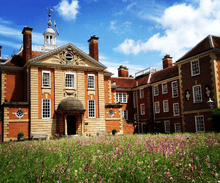
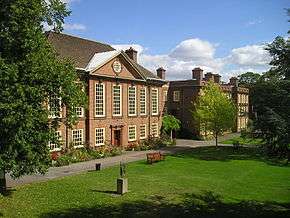
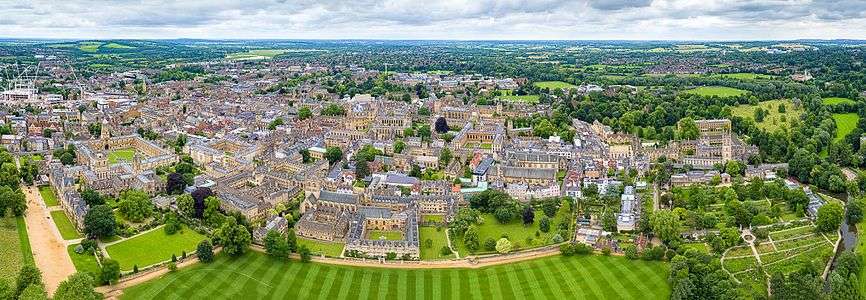

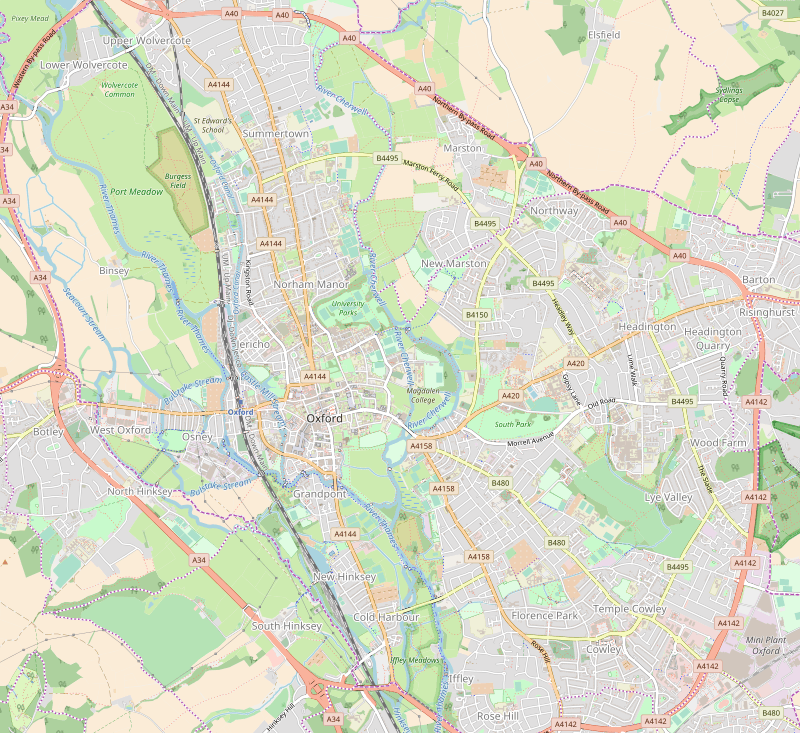
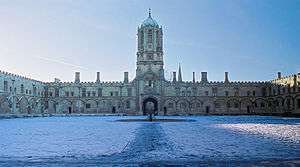
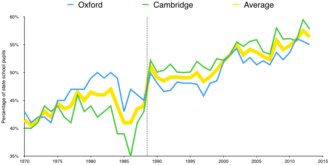
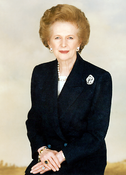
.jpg)
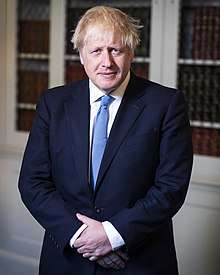

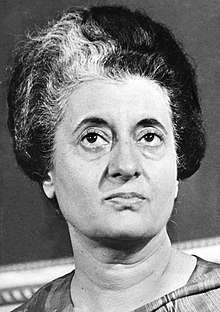

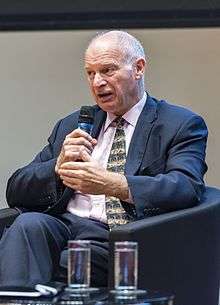
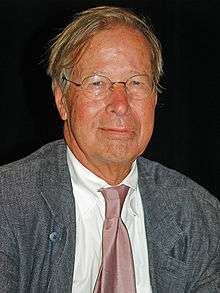
.jpg)
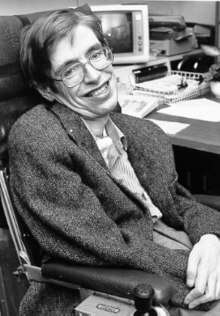
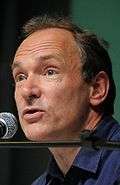
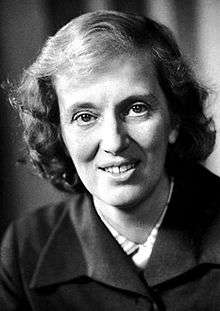
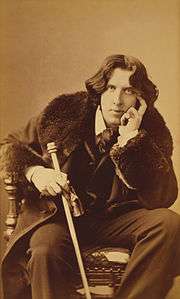


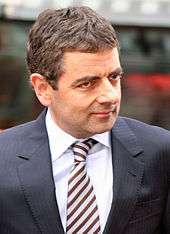
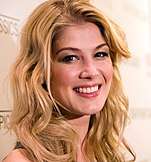


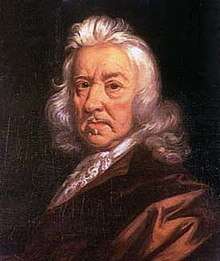

.jpg)
